2014/01/30: Daytona Beach
Category: General
Posted by: The Agnew Family
Another cool and rainy day. After a day in the condo we all were ready
to go somewhere or do something, so we hopped in the car and drove
south.
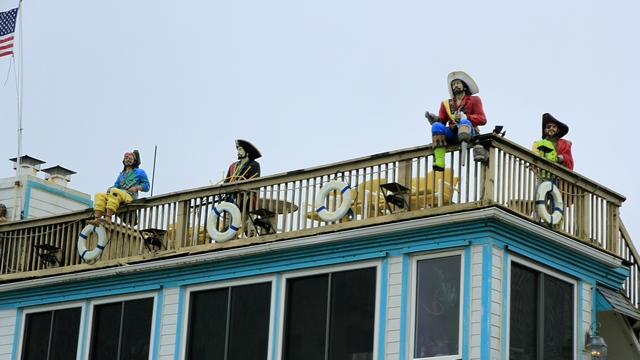
Watch out for pirates!
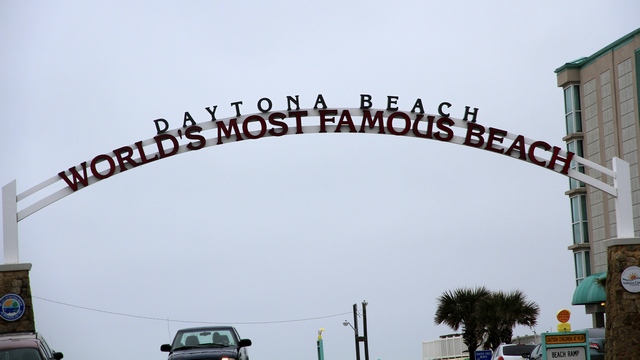
We ended up in Daytona Beach. This beach is really hard packed, so John was able to drive on it. The sky was gray and the waves were high.
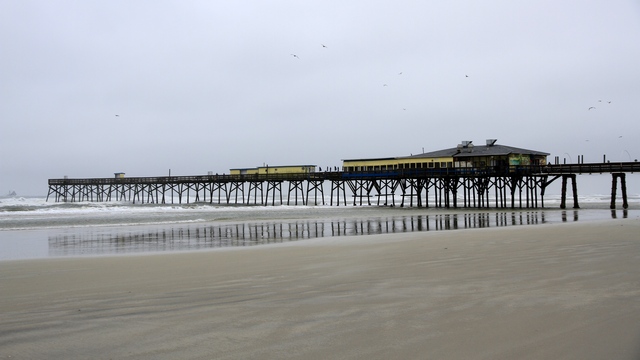
The Daytona pier.
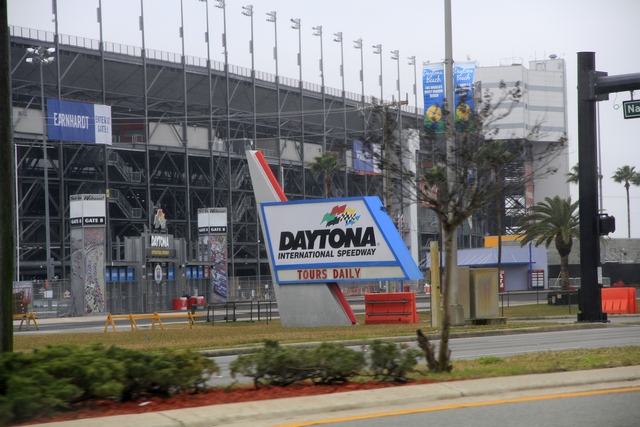
The Daytona Speedway. We decided driving by was good enough, didn't need a tour.
Watch out for pirates!
We ended up in Daytona Beach. This beach is really hard packed, so John was able to drive on it. The sky was gray and the waves were high.
The Daytona pier.
The Daytona Speedway. We decided driving by was good enough, didn't need a tour.
2014/01/29: Day of Rest
Category: General
Posted by: The Agnew Family
Winter storm Leon is passing by about 100 miles north of us causing a
high today of 42 and rain. We're happy that the storm stayed north of us
as a couple of inches of snow is causing great disasters. There's
nothing we want to do that is indoors, so we decided to have a day of
rest and hang out at the condo.
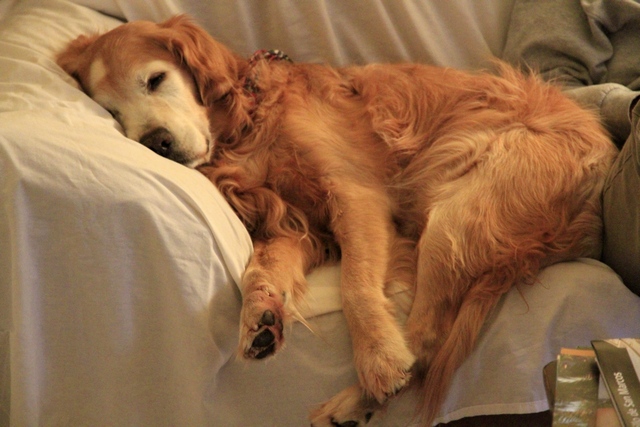
Zaph has perfected resting.

Last week we went to out to dinner to the Sunset Grille and really enjoyed it. After asking a few locals for restaurant recommendations and being told the Sunset Grille is the place to go for seafood we decided to go back to the Sunset Grille. Ed and I both ordered the Minorcan Chowder again and it was just as good as the first time. My main course was the award winning Shrimp and Grits and it was amazing. The grits are mixed with with three types of cheese and deep fried and served with shrimp in a tomato sauce that was similar to the chowder. Ed had Macadamian Crusted Mahi Mahi which came with an orange colored hair like vegetable on top. One of the few items Ed doesn't eat is sweet potatoes and yup that orange vegetable was sweet potato. Ed said the fish was really good.
Zaph has perfected resting.
Last week we went to out to dinner to the Sunset Grille and really enjoyed it. After asking a few locals for restaurant recommendations and being told the Sunset Grille is the place to go for seafood we decided to go back to the Sunset Grille. Ed and I both ordered the Minorcan Chowder again and it was just as good as the first time. My main course was the award winning Shrimp and Grits and it was amazing. The grits are mixed with with three types of cheese and deep fried and served with shrimp in a tomato sauce that was similar to the chowder. Ed had Macadamian Crusted Mahi Mahi which came with an orange colored hair like vegetable on top. One of the few items Ed doesn't eat is sweet potatoes and yup that orange vegetable was sweet potato. Ed said the fish was really good.
2014/01/28: Flagler College
Category: General
Posted by: The Agnew Family
In 1888, Henry Flagler built the exclusive hotel the Ponce de Leon.
Rooms were only available for the winter season (January through March)
and in todays dollars, a season would run between $100,000 and $250,000.
In 1968 the hotel became the centerpiece of the newly established
Flagler College. Today, students eat in what was the hotel's dining
room, co-ed students live in the hotel rooms and many classes are held
in historic buildings. Tours are offered to the public twice a day and
today we took one of them. This is a tour that I would highly recommend
to anyone visiting the St. Augustine area.
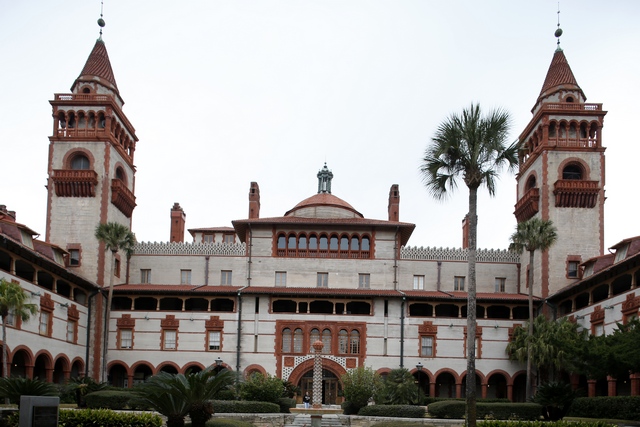
The main entrance of the Flagler College. The fountain in the front is also a sun dial.
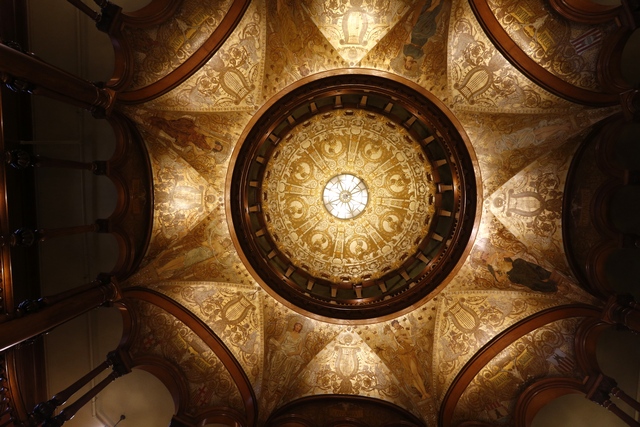
In the rotunda, you can stare up into an 80-foot domed ceiling. The gold leafed murals in the ceiling were painted by George W. Maynard.
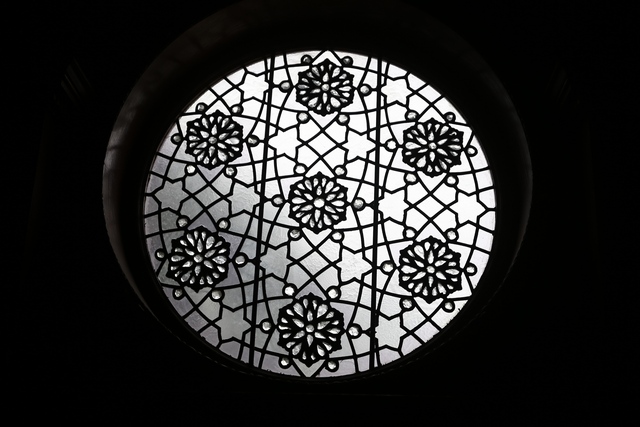
One of the two round Tiffany windows in the Ponce de Leon. The dining room has 79 of Louis Comfort Tiffany’s stained glass windows on display.

Stained glass windows on the stair well.

The center portion of the dining room. This part of the dining room was used as a ballroom. The ceiling was also painted by George W. Maynard. The chairs and tables are replicas of the original dining room furniture.
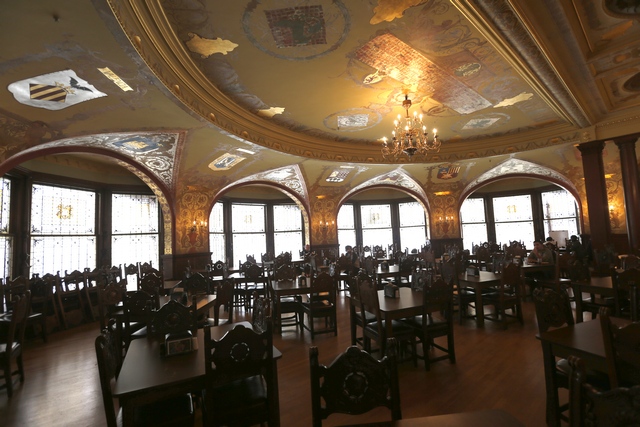
One of the sides of the dining room. You can see some of the 79 stained glass windows and more murals by George W. Maynard.
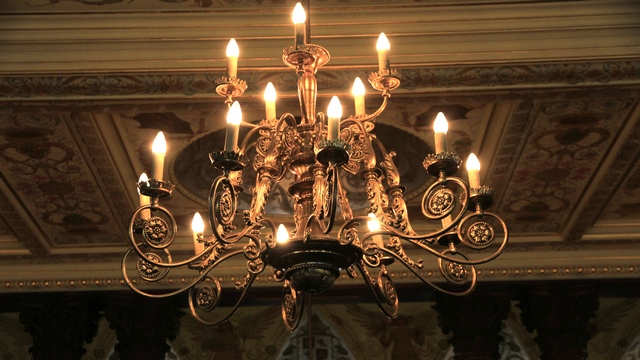
The chandelier was designed by Tiffany.


One side of the rotunda had rooms for the gentlemen while the other side was a woman's parlor. The tour took us into the parlor which consisted on three rooms. Two of the fireplaces in the woman's parlor. The fireplace on the left has a clock created by Edison.

Another chandelier that was designed by Tiffany. Notice the blue paint above the chandelier and around the plaster. That is known as Tiffany Blue .... the color of Tiffany boxes.
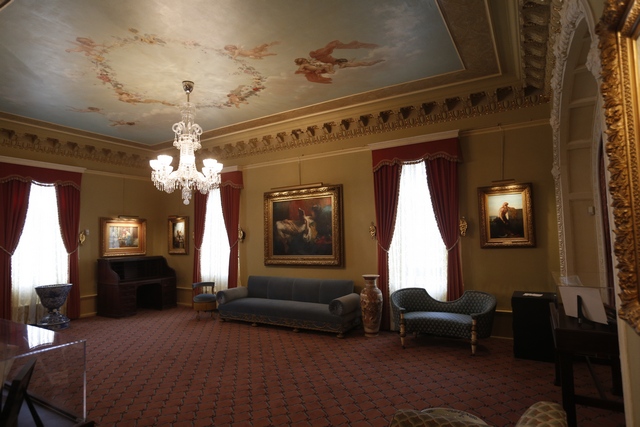
One of the rooms in the parlor.
We walked around the streets surrounding the college.
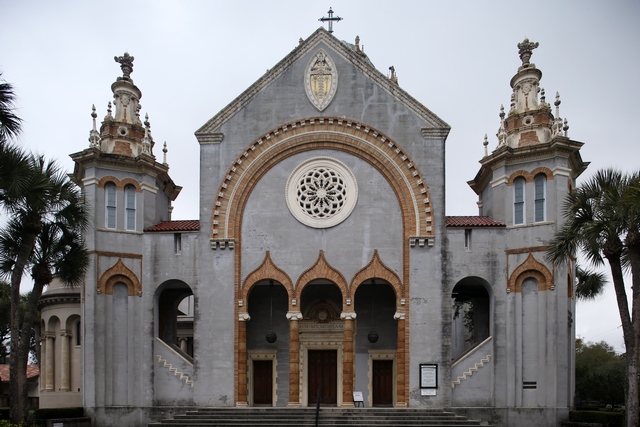
After Henry Flagler's daughter died in childbirth, Flagler commissioned a church to be built in her memory. In 1889 the Memorial Presbyterian Church was built. It is a example of Venetian Renaissance architecture with a dome that is more than 100 feet in height. Henry, his first wife, daughter and her child are buried in the mausoleum.
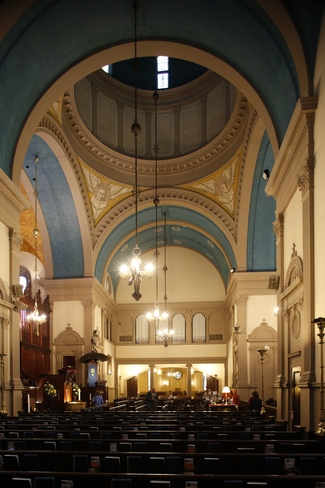
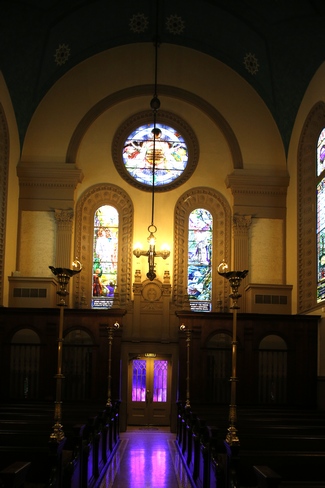
The inside of the church.
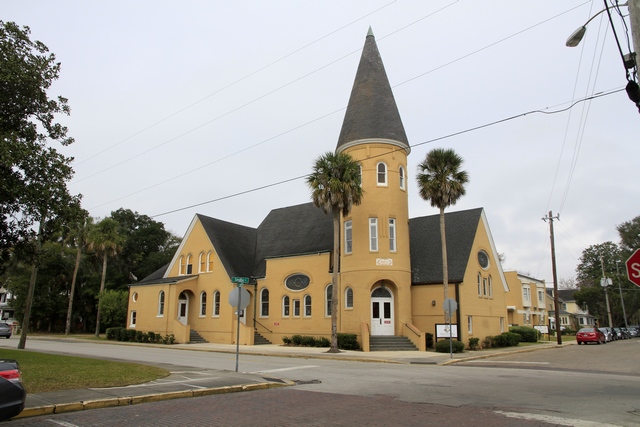
The Ancient City Baptist Church was built in 1895 with help from Henry Flagler. The style of architecture is Romanesque Revival with a cone shaped turret on top of a three story tower.
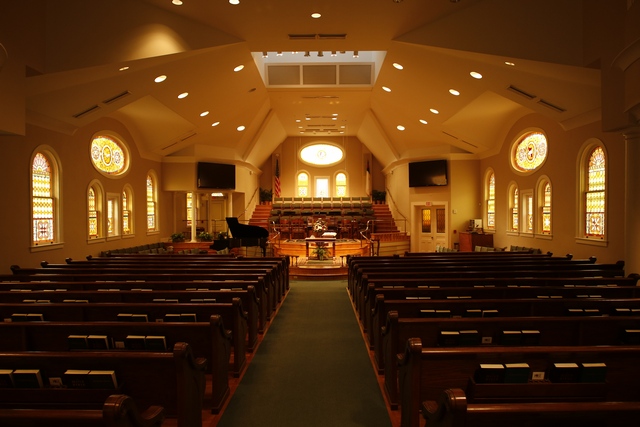
The inside of the Baptist church.

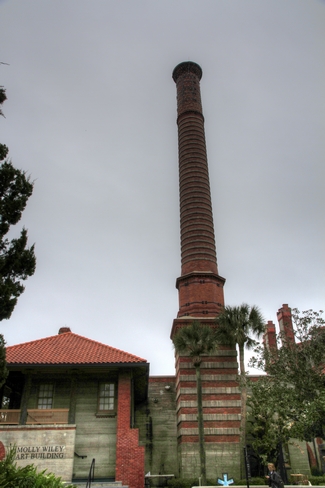
The photo on the left is the Grace Methodist Church that was built by Henry Flagler in 1887 by the same architects and builders of the Ponce de Leon. This church replaced the Oliver Methodist church, a wooden building that stood on the site where Flagler wanted to build the hotel Alcazar. The photo on right is of the artist studio that Flagler built to attract artists to the Ponce de Leon.
The main entrance of the Flagler College. The fountain in the front is also a sun dial.
In the rotunda, you can stare up into an 80-foot domed ceiling. The gold leafed murals in the ceiling were painted by George W. Maynard.
One of the two round Tiffany windows in the Ponce de Leon. The dining room has 79 of Louis Comfort Tiffany’s stained glass windows on display.
Stained glass windows on the stair well.

The center portion of the dining room. This part of the dining room was used as a ballroom. The ceiling was also painted by George W. Maynard. The chairs and tables are replicas of the original dining room furniture.
One of the sides of the dining room. You can see some of the 79 stained glass windows and more murals by George W. Maynard.
The chandelier was designed by Tiffany.
One side of the rotunda had rooms for the gentlemen while the other side was a woman's parlor. The tour took us into the parlor which consisted on three rooms. Two of the fireplaces in the woman's parlor. The fireplace on the left has a clock created by Edison.
Another chandelier that was designed by Tiffany. Notice the blue paint above the chandelier and around the plaster. That is known as Tiffany Blue .... the color of Tiffany boxes.
One of the rooms in the parlor.
We walked around the streets surrounding the college.
After Henry Flagler's daughter died in childbirth, Flagler commissioned a church to be built in her memory. In 1889 the Memorial Presbyterian Church was built. It is a example of Venetian Renaissance architecture with a dome that is more than 100 feet in height. Henry, his first wife, daughter and her child are buried in the mausoleum.
The inside of the church.
The Ancient City Baptist Church was built in 1895 with help from Henry Flagler. The style of architecture is Romanesque Revival with a cone shaped turret on top of a three story tower.
The inside of the Baptist church.


The photo on the left is the Grace Methodist Church that was built by Henry Flagler in 1887 by the same architects and builders of the Ponce de Leon. This church replaced the Oliver Methodist church, a wooden building that stood on the site where Flagler wanted to build the hotel Alcazar. The photo on right is of the artist studio that Flagler built to attract artists to the Ponce de Leon.
2014/01/27: Nao Victoria and El Galeon
Category: General
Posted by: The Agnew Family
In the St. Augustine harbor are two tall ships, the Nao Victoria and the
El Galeon. The Nao Victoria is a replica of the first ship to
successfully circumnavigate the world. El Galeón is a replica of the
vessels that traveled the coasts of Florida between the 16th and 18th
centuries, transporting men, goods, culture and ideas, creating ties
between America and Europe. The Nao Victoria arrived December 23rd and
is scheduled to leave February 1st while El Galeon arrived January 5th
and is staying till July.

Nao Victoria is in the foreground and El Galeon is in the back.

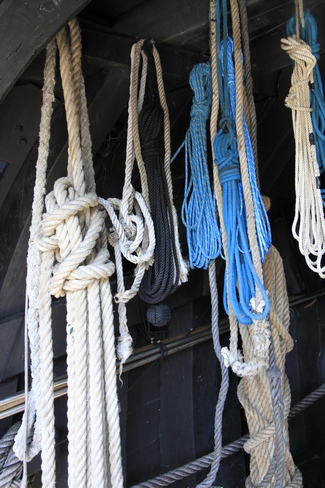
When we boarded the Nao Victoria we spoke (or tried to) to the ships cook, a young Spanish lad. He told us that there are no showers on the ship and they did a two week trip from Spain to Puerto Rico. The galley is on the main deck and consisted of some cupboards and a two burner stove top. The first photo is looking down the deck of the Nao Victoria. The second photo are the ropes hanging on the deck.
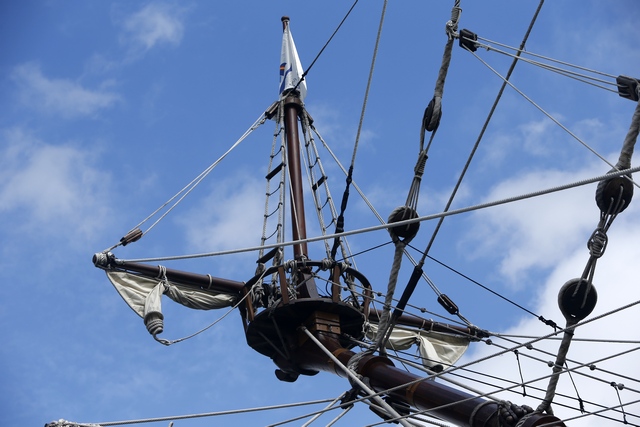
El Galeon is a much large ship than the Nao Victoria. Looking at the crows nest on El Galeon.

The canon deck of the El Galeon. The canons are replicas and have been fired once. A video showed the building of the ship ---- both old construction technics and state of the art technics were used.

While we were touring El Galeon, the draw bridge went up. What a great vantage point.
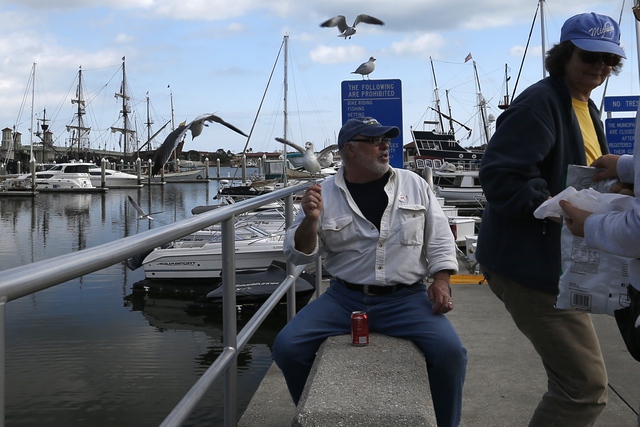
We decided to have a picnic lunch on some benches on the pier. It wasn't long before the sea gulls were visiting --- might have had something to do the the bread John held up for the birds.

A jelly fish was swimming near the shore.
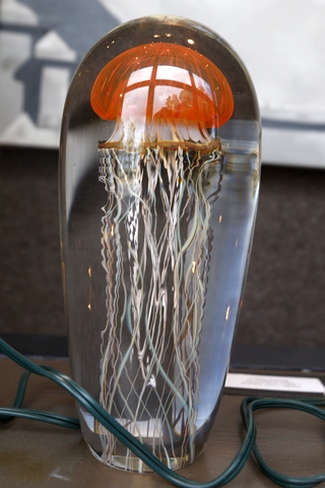
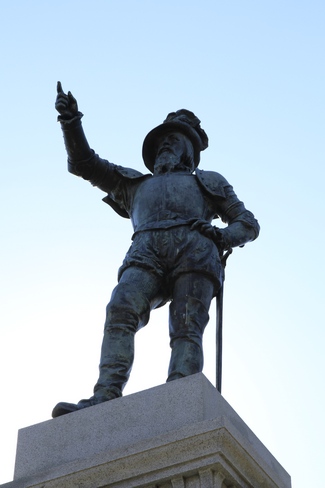
One of the local art galleries had glass jelly fish that Ed and I both like, unfortunately they were out of our budget. The statue of Ponce de Leon in the plaza.
Nao Victoria is in the foreground and El Galeon is in the back.
When we boarded the Nao Victoria we spoke (or tried to) to the ships cook, a young Spanish lad. He told us that there are no showers on the ship and they did a two week trip from Spain to Puerto Rico. The galley is on the main deck and consisted of some cupboards and a two burner stove top. The first photo is looking down the deck of the Nao Victoria. The second photo are the ropes hanging on the deck.
El Galeon is a much large ship than the Nao Victoria. Looking at the crows nest on El Galeon.
The canon deck of the El Galeon. The canons are replicas and have been fired once. A video showed the building of the ship ---- both old construction technics and state of the art technics were used.
While we were touring El Galeon, the draw bridge went up. What a great vantage point.
We decided to have a picnic lunch on some benches on the pier. It wasn't long before the sea gulls were visiting --- might have had something to do the the bread John held up for the birds.

A jelly fish was swimming near the shore.
One of the local art galleries had glass jelly fish that Ed and I both like, unfortunately they were out of our budget. The statue of Ponce de Leon in the plaza.
2014/01/26: Seafood Boil
Category: General
Posted by: The Agnew Family
After all the walking we did yesterday, we decided a drive was in order.
Driving north of St. Augustine brought us to the Guana Tolomato
Matanzas National Estuarine Research Reserve. We had hoped for some
great views of the ocean but got a view of dense vegetation on tall sand
dunes. We stopped at one of the parking lots along the way and took a
short walk on the beach.
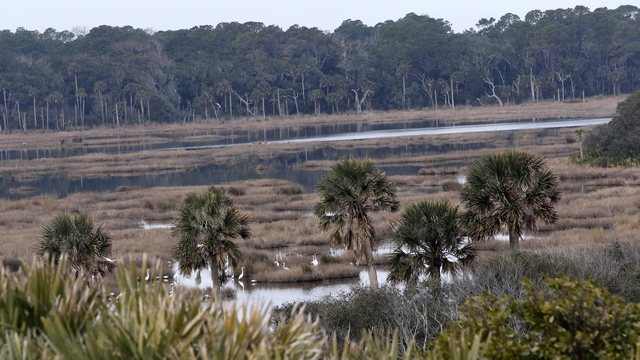
There was an estuary on the opposite side of the road from the ocean. If you look closely you'll see lots of egrets in the foreground of the photo. Unfortunately, for photographer Ed you couldn't get any closer to the birds. The estuary area was closed to the public.
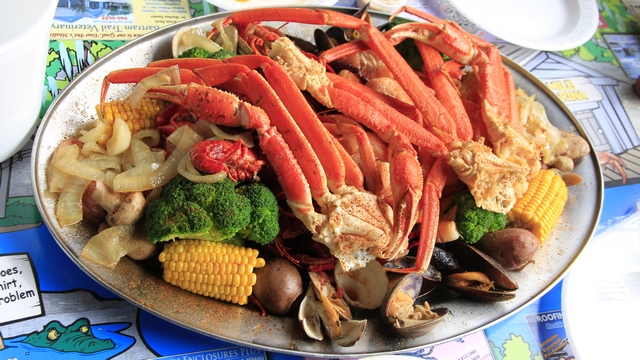
Before we left home, my friend Margaret told me about a restaurant she had tried when she visited St. Augustine a number of years ago. We decided to look for the Outback Crab Shack on our drive. John and Carol have never had the pleasure of eating a seafood boil so we gave it a whirl. One platter of food serves four people ... even when you include Ed.

The restaurant is at a marina on the St. Johns River. The dock seems to go on forever.
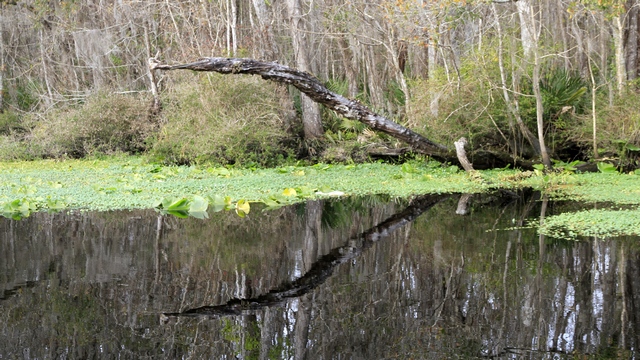
Use your imagination and you too can see Ed's sea serpent.
There was an estuary on the opposite side of the road from the ocean. If you look closely you'll see lots of egrets in the foreground of the photo. Unfortunately, for photographer Ed you couldn't get any closer to the birds. The estuary area was closed to the public.
Before we left home, my friend Margaret told me about a restaurant she had tried when she visited St. Augustine a number of years ago. We decided to look for the Outback Crab Shack on our drive. John and Carol have never had the pleasure of eating a seafood boil so we gave it a whirl. One platter of food serves four people ... even when you include Ed.
The restaurant is at a marina on the St. Johns River. The dock seems to go on forever.
Use your imagination and you too can see Ed's sea serpent.
2014/01/25: Night Lights
Category: General
Posted by: The Agnew Family
We started the day with a stop at the fort. Ed and John wanted to take pictures of the canon firing from the sea wall.

The volunteers did a great job being the Spanish soldiers. They reenacted the canon drill that the Spanish were known to do.
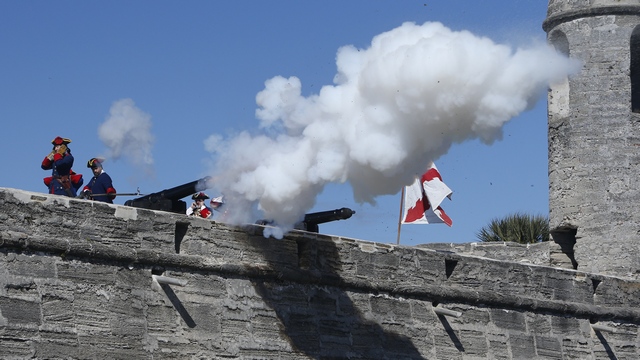
When the command "cover your ears" was given the pigeons sitting on the tower roof flew away.
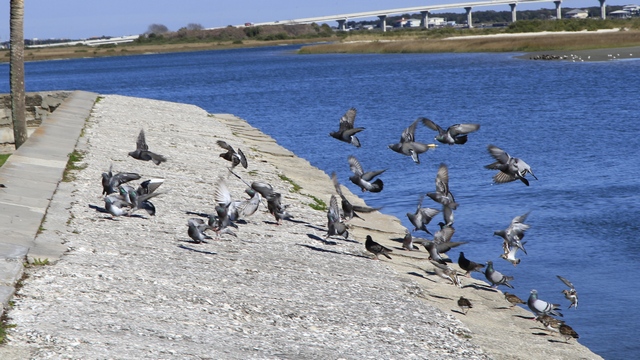
After the canon fired the pigeons returned to eat the bread that was fired from the canon.
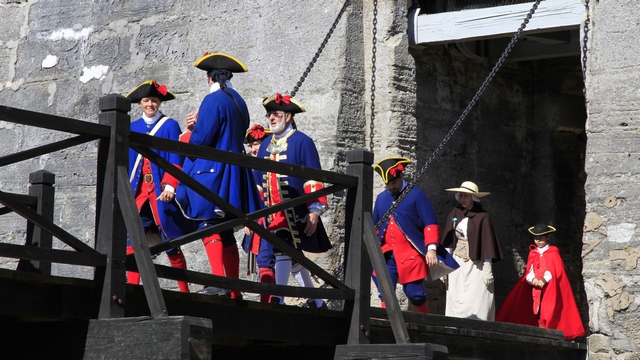
Dressing up is a family affair.
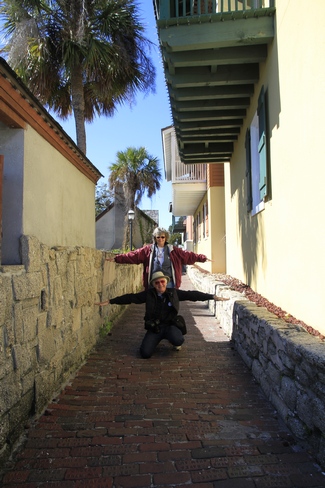
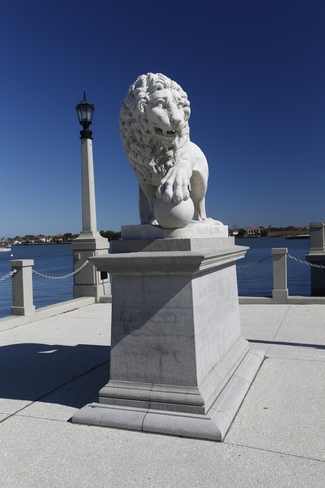
Treasury Street is the narrowest street in St. Augustine. The idea was to protect the Treasury from robbery ---- it didn't work. The street is just slightly wider than Carol and Ed's reach. One of the two lions that give the draw bridge it's name "Bridge of Lions".
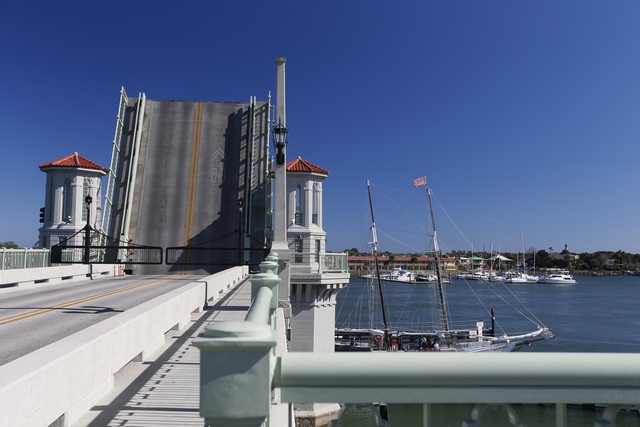
We decided to walk up the bridge to look down at the boats in the harbor. As we were nearing the middle of the bridge, the gates went down and the bridge went up. Ed caught a sailboat going through the opening.

The flags on this house show that it was around during all of the different occupations of the city --- starting at the right --- 1st Spanish occupation, the English, the 2nd occupations by the Spanish, the confederacy and finally US.
We had read that the "Night of Lights" is a world famous display of lights, so Ed, Zaph and I decided to go downtown tonight to check it out. St. Augustine was really hopping as it was Saturday --- I think every restaurant was busy and had live entertainment.
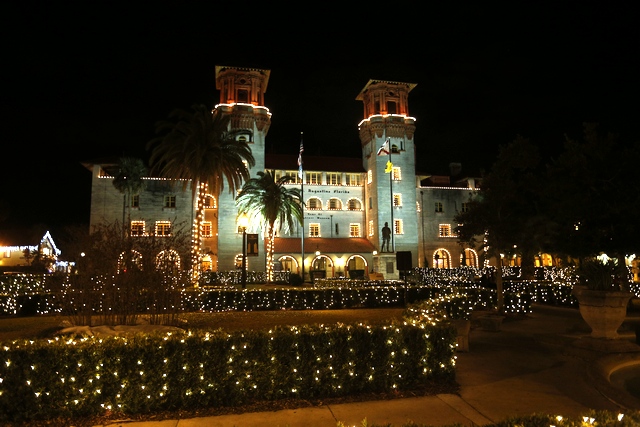
The building that houses the Lightner museum is also the St. Augustine city hall. Every bush and tree was lit up.

This bed and breakfast also got into the act. The trees in the foreground are made out of plastic. I think they would look great in front of house.
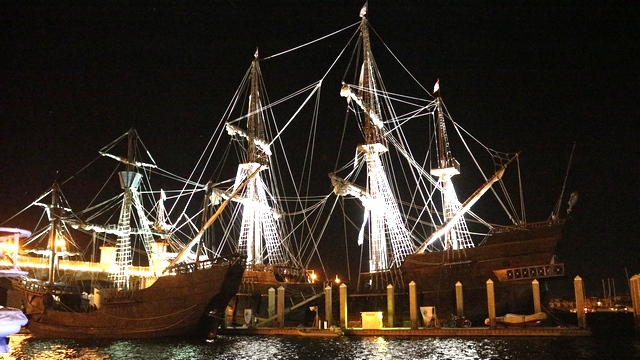
El Galeon and Nao Victoria, replicas of Spanish ships in the harbor.
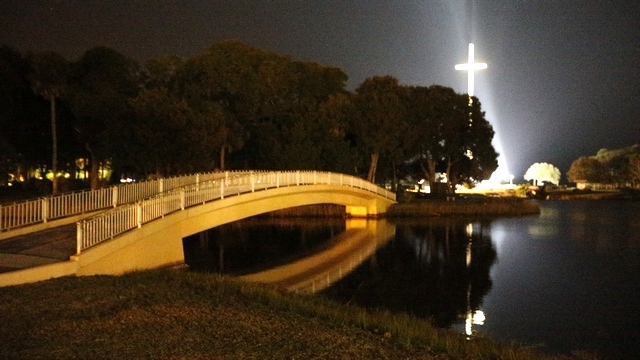
The cross at the Mission Nombre de Dios. The cross marks the location of the first mass after Ponce de Leon landed in St. Augustine.
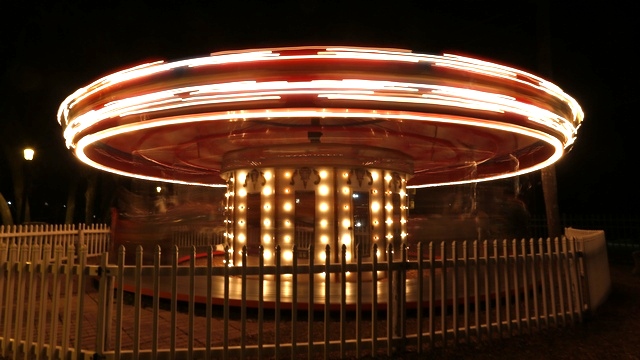
A one second exposure of a carousel.
The volunteers did a great job being the Spanish soldiers. They reenacted the canon drill that the Spanish were known to do.
When the command "cover your ears" was given the pigeons sitting on the tower roof flew away.
After the canon fired the pigeons returned to eat the bread that was fired from the canon.
Dressing up is a family affair.
Treasury Street is the narrowest street in St. Augustine. The idea was to protect the Treasury from robbery ---- it didn't work. The street is just slightly wider than Carol and Ed's reach. One of the two lions that give the draw bridge it's name "Bridge of Lions".
We decided to walk up the bridge to look down at the boats in the harbor. As we were nearing the middle of the bridge, the gates went down and the bridge went up. Ed caught a sailboat going through the opening.

The flags on this house show that it was around during all of the different occupations of the city --- starting at the right --- 1st Spanish occupation, the English, the 2nd occupations by the Spanish, the confederacy and finally US.
We had read that the "Night of Lights" is a world famous display of lights, so Ed, Zaph and I decided to go downtown tonight to check it out. St. Augustine was really hopping as it was Saturday --- I think every restaurant was busy and had live entertainment.
The building that houses the Lightner museum is also the St. Augustine city hall. Every bush and tree was lit up.
This bed and breakfast also got into the act. The trees in the foreground are made out of plastic. I think they would look great in front of house.
El Galeon and Nao Victoria, replicas of Spanish ships in the harbor.
The cross at the Mission Nombre de Dios. The cross marks the location of the first mass after Ponce de Leon landed in St. Augustine.
A one second exposure of a carousel.
2014/01/24: Day Off
Category: General
Posted by: The Agnew Family
Ed and I hung around the condo today. As with every long trip to the US,
Ed placed an order with B&H; Camera and UPS is suppose to deliver
it today. The high today is only 44F so it's not a bad day to stay
indoors. Ed and I took turns running a couple of errands so we did
accomplish a few things. About 6pm, the status on Ed's order changed to
"Delivery on Monday". I was not happy about this so Ed called UPS to see
if he could pick the package up somewhere and yes he could pick the
package up at the UPS depot in St. Augustine. It's good to know this so
in the future Ed can request the order to be sent to the depot for
pickup. Yeah!!! no more waiting all day for packages to arrive.
2014/01/23: Lightner Museum
Category: General
Posted by: The Agnew Family
The Alcazar Hotel was built by Henry Flagler in 1888. To keep the hotel
guests entertained the back portion of the building was a casino and
included a ballroom, swimming pool, Turkish Baths, Russian Baths and a
gymnasium. Due to the depression, the hotel closed in the 1930s. In 1946
Otto Lightner purchased the hotel to house all of the items he had
collected over the years. Today the building is owned by the City of St.
Augustine and is known as the Lightner Museum.
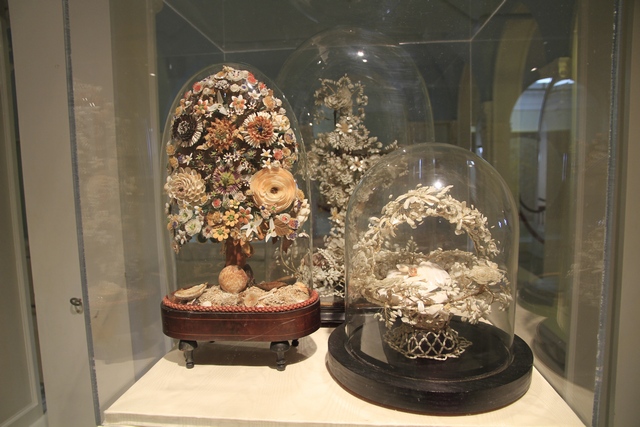
During the depression Otto Lightner purchased many items from the wealthy who were forced to sell off some their possessions. Due to this, his collections are many and cover a large range of items. These three items are made completely of shells.

There were a number of Chrystal pieces.
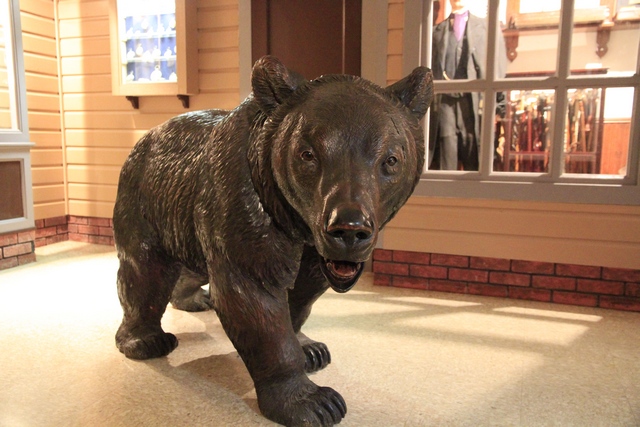
This was my favorite item in the museum. Couldn't figure out how to fit him in my purse.

There were some beautiful pieces of furniture.

There is an extensive collection of music boxes including a nickelodeon, Violano-Virtuosa and The Gem Rollerorgan that the guide is playing.
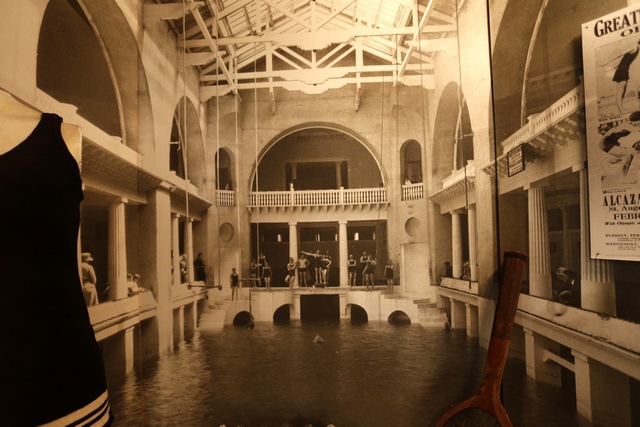
The building was as interesting as the items inside the building. From the third floor ballroom you could look down into what was the pool. The guests entered the pool from the second floor. The roof over the pool was made of glass and opened to allow ventilation (the spring water smell of sulpher). This photo shows what the pool looked like when it was being used.
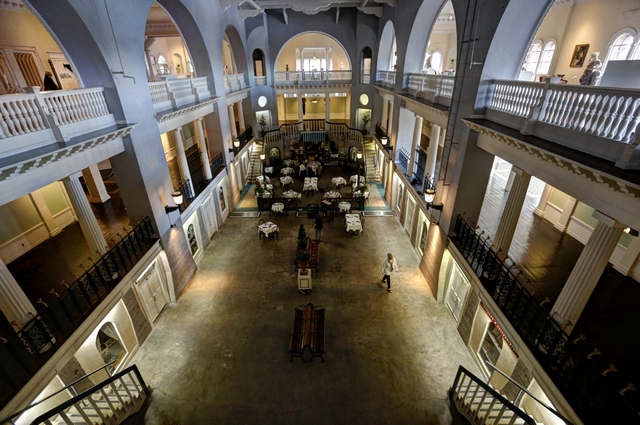
This is what the pool looks like today. The glass roof caved in during the 15 or so years the the building was closed and has been replaced with a solid roof. A restaurant occupies the deep end of the pool and shops line the sides of the pool.
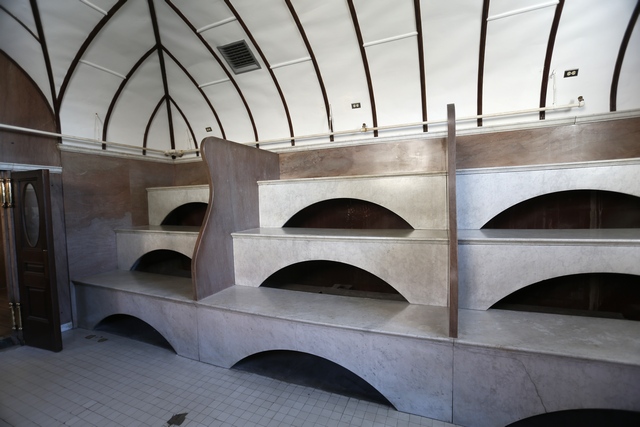
The Russian Bath or steam room had lots of seating. The Turkish Bath, towel rooms and a massage room were located nearby.

The fountain at the front of the Lightner Museum looking across the road at the Flagler College. The Flagler College resides in what was once the hotel for the rich and famous .... the Ponce de Leon.

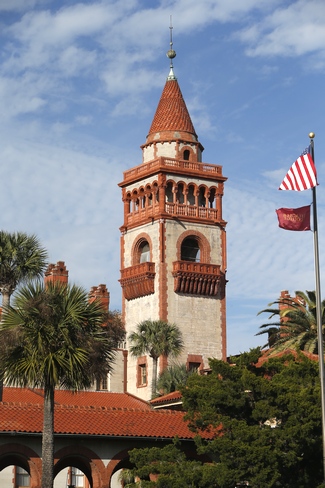
Across the side street from the Lightner Museum is the Casa Monica Hotel. Franklin Smith built this hotel in 1888, but unfortunately it did not do well and he sold it to Henry Flagler four months after it opened. This building operated as the St. Johns County Courthouse from 1968 to 1997. In 1997 the building was aquired by Richard Kessler who completely renovated the building and it reopened as a hotel in 1999. The second photo is a tower on the Flagler College.
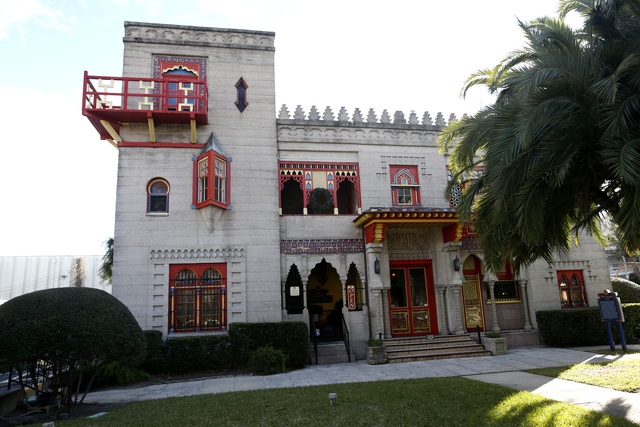
Villa Zorayda was built in 1883 in a Moorish Revival style modeled after the Alhambra Castle in Spain. It's a very colorful building.
During the depression Otto Lightner purchased many items from the wealthy who were forced to sell off some their possessions. Due to this, his collections are many and cover a large range of items. These three items are made completely of shells.
There were a number of Chrystal pieces.
This was my favorite item in the museum. Couldn't figure out how to fit him in my purse.

There were some beautiful pieces of furniture.
There is an extensive collection of music boxes including a nickelodeon, Violano-Virtuosa and The Gem Rollerorgan that the guide is playing.
The building was as interesting as the items inside the building. From the third floor ballroom you could look down into what was the pool. The guests entered the pool from the second floor. The roof over the pool was made of glass and opened to allow ventilation (the spring water smell of sulpher). This photo shows what the pool looked like when it was being used.

This is what the pool looks like today. The glass roof caved in during the 15 or so years the the building was closed and has been replaced with a solid roof. A restaurant occupies the deep end of the pool and shops line the sides of the pool.
The Russian Bath or steam room had lots of seating. The Turkish Bath, towel rooms and a massage room were located nearby.
The fountain at the front of the Lightner Museum looking across the road at the Flagler College. The Flagler College resides in what was once the hotel for the rich and famous .... the Ponce de Leon.
Across the side street from the Lightner Museum is the Casa Monica Hotel. Franklin Smith built this hotel in 1888, but unfortunately it did not do well and he sold it to Henry Flagler four months after it opened. This building operated as the St. Johns County Courthouse from 1968 to 1997. In 1997 the building was aquired by Richard Kessler who completely renovated the building and it reopened as a hotel in 1999. The second photo is a tower on the Flagler College.
Villa Zorayda was built in 1883 in a Moorish Revival style modeled after the Alhambra Castle in Spain. It's a very colorful building.
2014/01/22: Museum Day
Category: General
Posted by: The Agnew Family
I'm not whining as I know it's much colder at home, but the high today
is only 50F and there's a cold breeze. We decided that it would be very
uncomfortable to ride the trolley so we opted to visit the Old Jail, the
Old Store and the History Museum as they are in the same location.
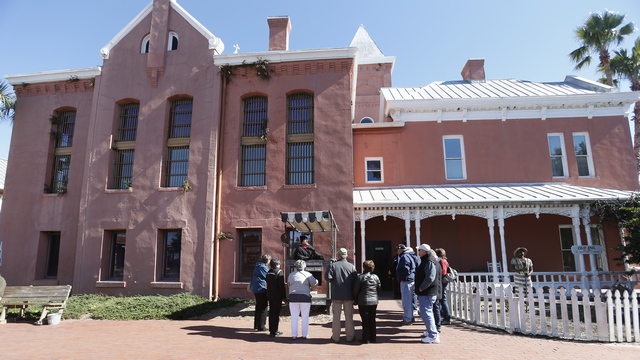
The Old Jail. In 1891, Henry Flagler gave the city of St. Augustine money to build a new jail when he realized the jail was across the street his new hotel. The money came with a couple of restrictions --- the jail had to be at least a mile from his hotel and the jail could not look like a jail. Tourist were know to knock on the door of the jail thinking the building was a hotel.

Don't think Ed would enjoy spending any amount of time in the cell.

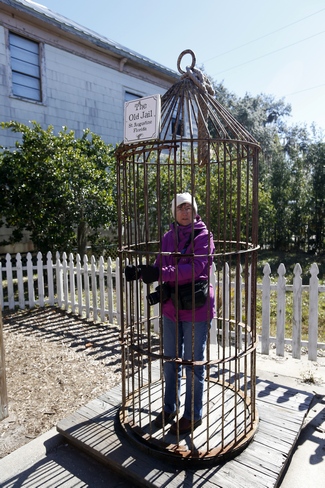
One of the first finger printing kits. If a prison did something against the rules they could end up in the stocks or in the cage. When the prisoner was in the cage it would be haulled up into a tree and the prisoner would remain there for a day or two.
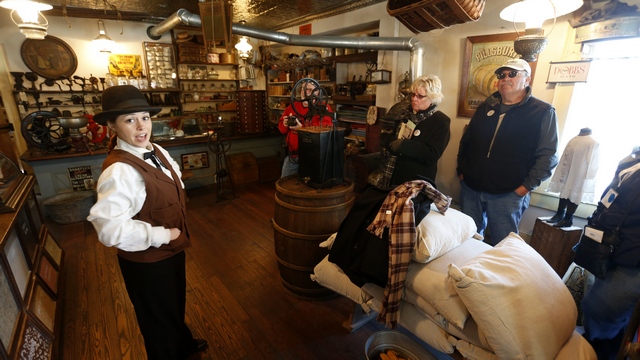
The old store.
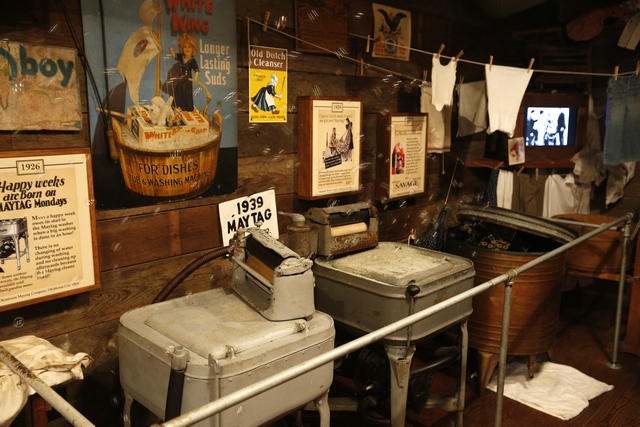
Some of the washing machines C.F. Hamblen sold.
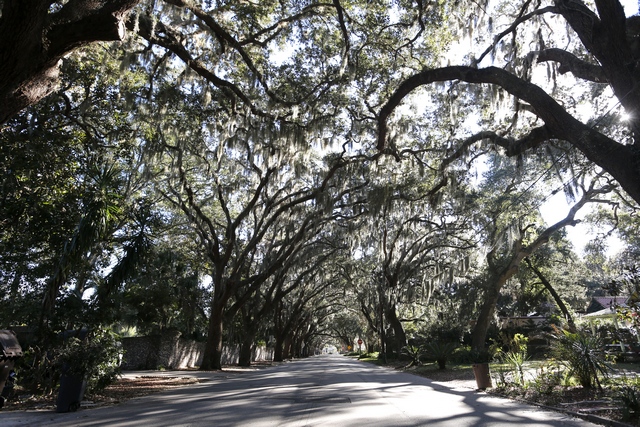
A long time ago a hard frost killed all of the Magnolia trees on Magnolia Avenue. Now the street is lined with Live Oak trees. National Geographic magazine called it one of the ten most beautiful streets in the country.
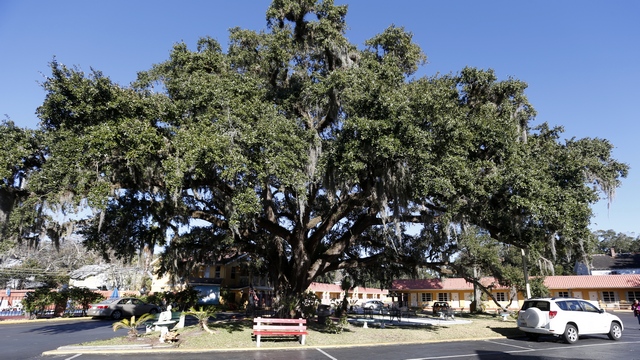
In the center of the Howard Johnson parking lot is the Old Senator. This Live Oak is 13 feet around and more than 600 years old.
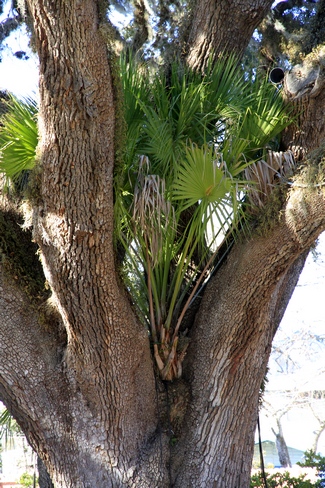
A Palm tree is growing in the middle of the Old Senator.
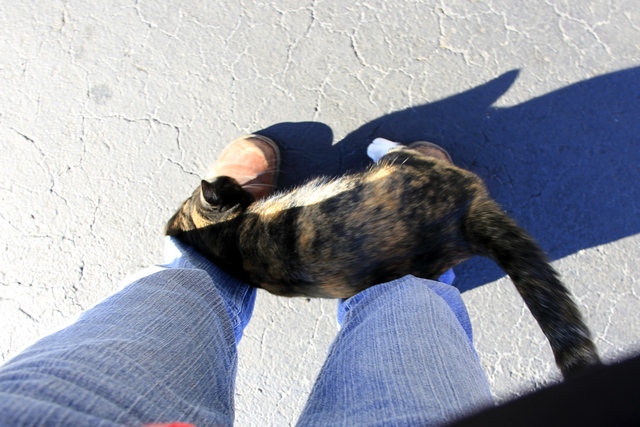
My new best friend.

We drove around the Abbott Tract area. This area features 124 historic buildings within 17 blocks. This section of the house is obviously an addition but we were impressed with stain glass window, think it came from an old bar.
The Old Jail. In 1891, Henry Flagler gave the city of St. Augustine money to build a new jail when he realized the jail was across the street his new hotel. The money came with a couple of restrictions --- the jail had to be at least a mile from his hotel and the jail could not look like a jail. Tourist were know to knock on the door of the jail thinking the building was a hotel.
Don't think Ed would enjoy spending any amount of time in the cell.
One of the first finger printing kits. If a prison did something against the rules they could end up in the stocks or in the cage. When the prisoner was in the cage it would be haulled up into a tree and the prisoner would remain there for a day or two.
The old store.
Some of the washing machines C.F. Hamblen sold.
A long time ago a hard frost killed all of the Magnolia trees on Magnolia Avenue. Now the street is lined with Live Oak trees. National Geographic magazine called it one of the ten most beautiful streets in the country.
In the center of the Howard Johnson parking lot is the Old Senator. This Live Oak is 13 feet around and more than 600 years old.
A Palm tree is growing in the middle of the Old Senator.
My new best friend.

We drove around the Abbott Tract area. This area features 124 historic buildings within 17 blocks. This section of the house is obviously an addition but we were impressed with stain glass window, think it came from an old bar.
2014/01/21: Lighthouse and Anastasia State Park
Category: General
Posted by: The Agnew Family
The St. Augustine Lighthouse can be seen from a long distance off ---
from St. Augustine Beach and St. Augustine. Ed and John decided to climb
the lighthouse and tour the grounds, while Carol, Zaph, Cait and I
opted to walk around the lighthouse neighborhood. This lighthouse is
fairly tall as you have to climb 219 steps to reach the top. The
lighthouse is 140 years old and is second lighthouse in this location.
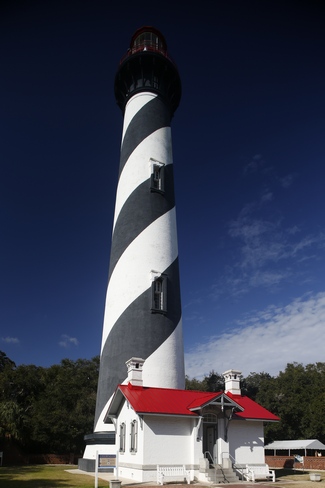
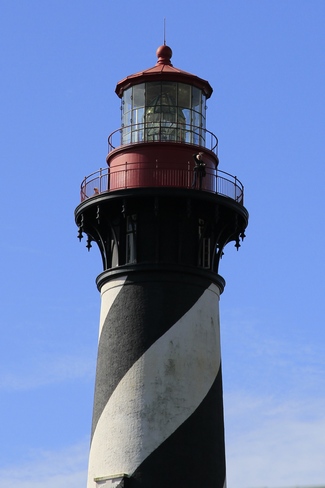
The lighthouse. That's Ed standing at the top waving at us.
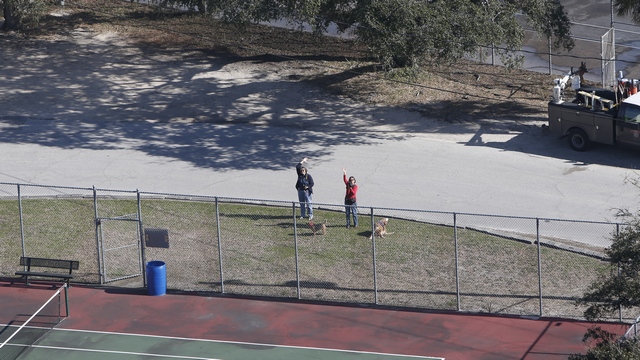
This is us waving back at Ed.

The view of St. Augustine from the top of the lighthouse.
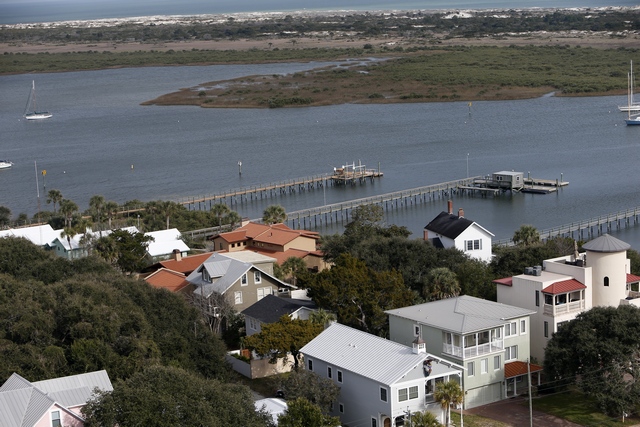
Looking out at the inland water way.

Inside the light.
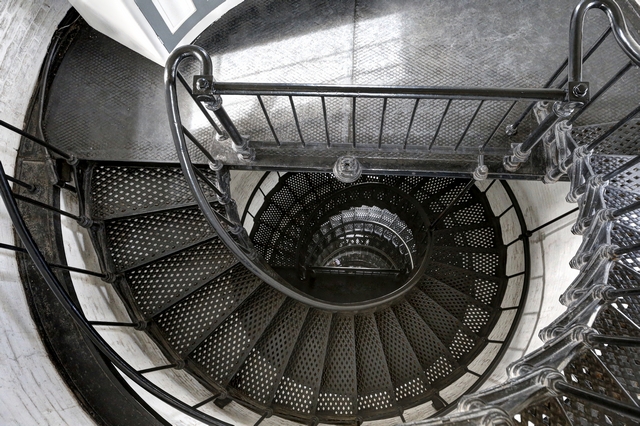
Looking down the steps.
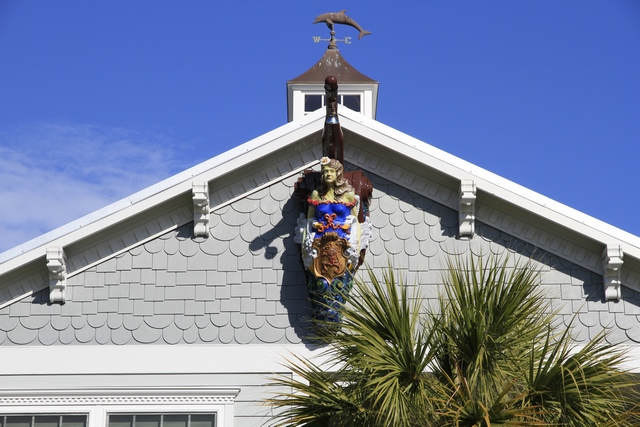
Carol and I found this house with a boat prow.

I could live here. This house is on the water. I shot the photo through the window in the gate. Just love the outdoor fireplace.

Carol and I walk down the fishing pier at the yacht club and found a couple of fishermen filleting fish. They threw the scrap pieces of fish into the water to the waiting pelicans. Small pieces of fish were picked off in the air by sea gulls.
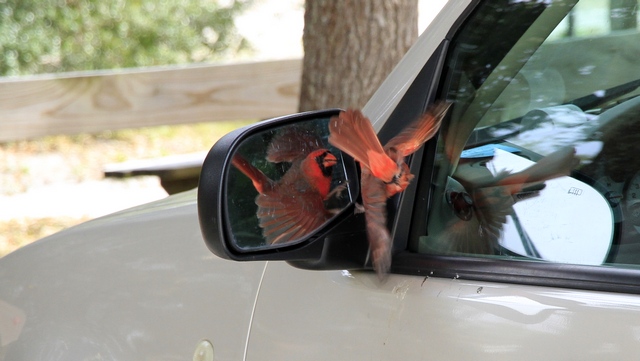
Ed had read that there was good birding at the local state park (Anastasia). Don't think the good birding is in January. We did see this cardinal attacking the side mirrors of vehicles.
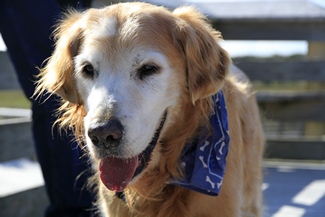
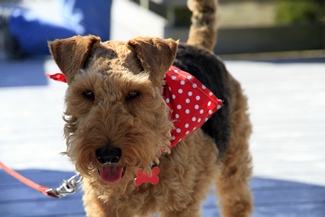
Zaph and Cait had a great time today.
The lighthouse. That's Ed standing at the top waving at us.
This is us waving back at Ed.
The view of St. Augustine from the top of the lighthouse.
Looking out at the inland water way.

Inside the light.

Looking down the steps.
Carol and I found this house with a boat prow.
I could live here. This house is on the water. I shot the photo through the window in the gate. Just love the outdoor fireplace.
Carol and I walk down the fishing pier at the yacht club and found a couple of fishermen filleting fish. They threw the scrap pieces of fish into the water to the waiting pelicans. Small pieces of fish were picked off in the air by sea gulls.
Ed had read that there was good birding at the local state park (Anastasia). Don't think the good birding is in January. We did see this cardinal attacking the side mirrors of vehicles.
Zaph and Cait had a great time today.
2014/01/20: Castillo de San Marcos
Category: General
Posted by: The Agnew Family
Picture perfect day today. The sun was shining, it was in the mid 60s
and there wasn't much wind. It's also Martin Luther King Day which means
that National Parks are free today and busy.
After several wooden forts were proved inadequate the Spanish built a more permanent fort. Construction of Castillo de San Marcos was started in 1672 and completed in 1695. It is built out of coquina, a rock that is naturally formed in the ocean from limestone and fossilized shells. Coquina is very soft when it is quarried and is left for one to three years to dry. Coquina was handy to build forts with because the heavy cannon balls would sink into the coquina instead of fracturing or breaking the structure.

When the Spanish walled the city in the 1700's this gate was the only way in and out of the city.
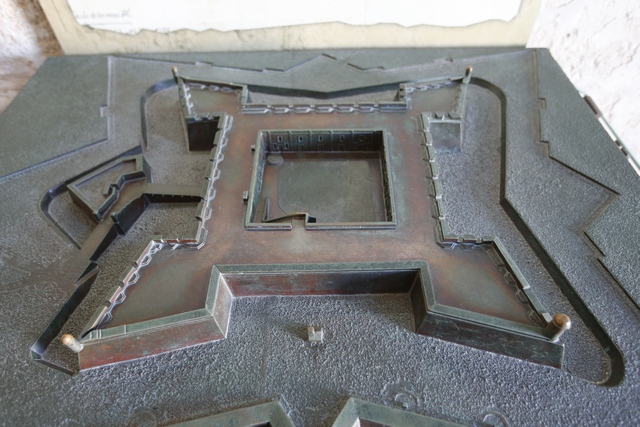
This is a model of the fort. Starting from the outside, there is the "glacis", a man-made slope giving the soldiers inside the fort a good view of area surrounding the fort; next is the moat which could be flooded with sea water; finally the walls of the fort. The corners protrude preventing blind spots.
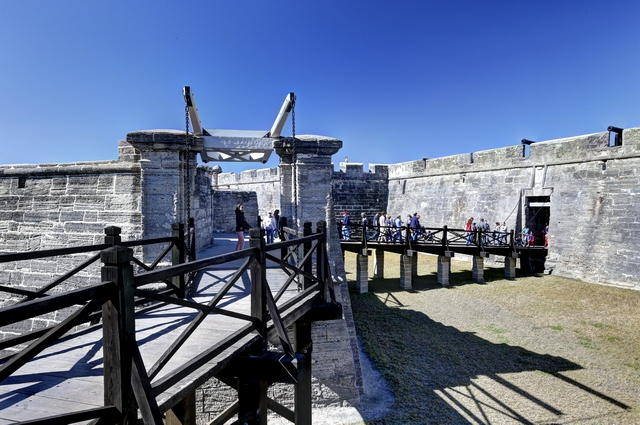
The drawbridge.
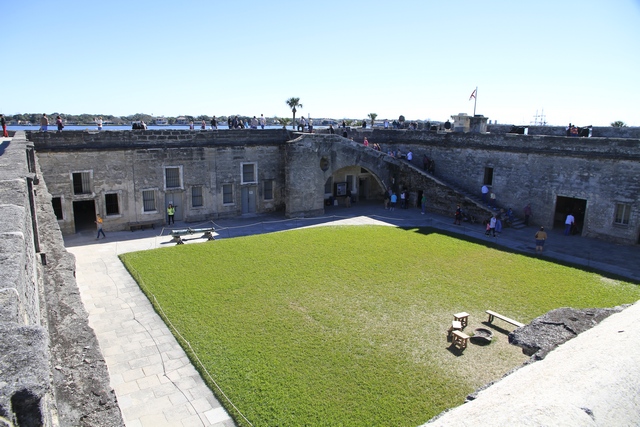
The courtyard of the fort. The soldiers lived in the city and came to the fort each day, so there are no living quarters.
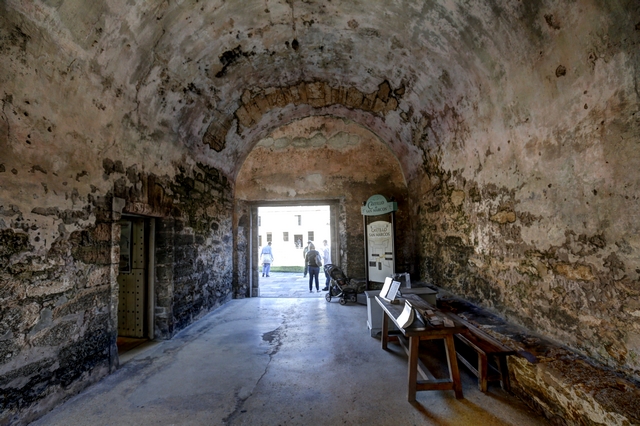
One of the storage vaults for gun powder and other ammunitions.
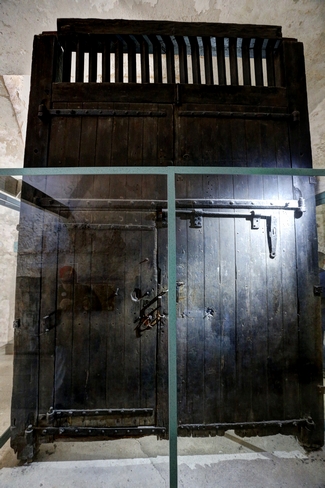
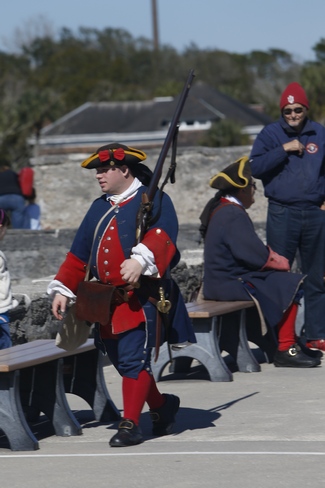
The original fort doors and couple of Spanish soldiers.
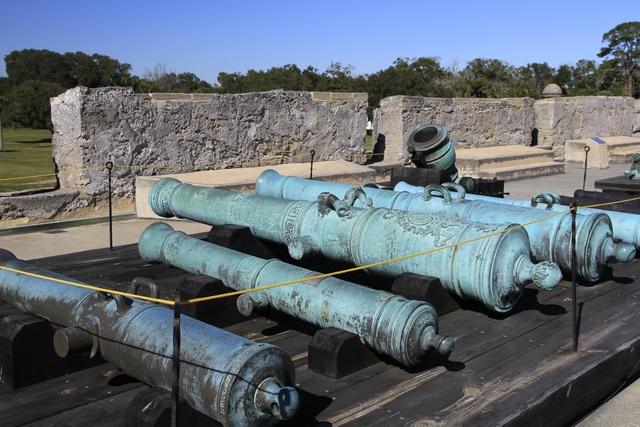
A few of the many cannons on display. Notice the design on the middle cannon.

Interesting picture Ed.
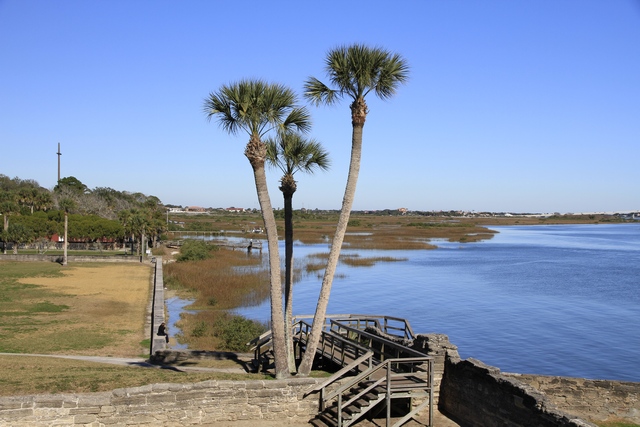
A view from the castle wall.
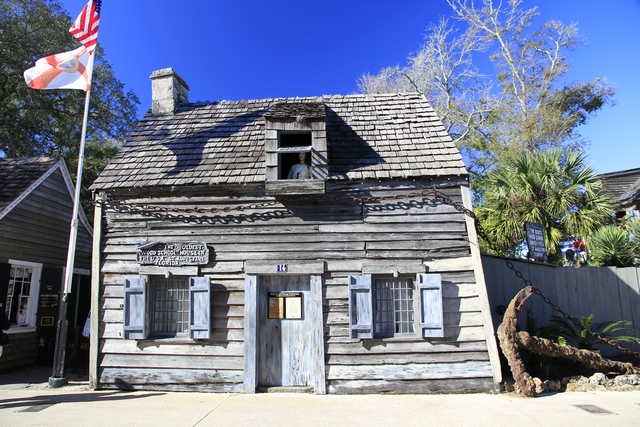
This school house was built more than 200 years ago out of red cedar and cypress. The building is encircled by a large chain, placed there in 1937, to help anchor it the ground in case of a hurricane.

The backyard of the school house contained a kitchen building. Think the chimney has seen better days as a chain is preventing it from falling down.

Wildlife ..... this fellow was digging around in the school yard.
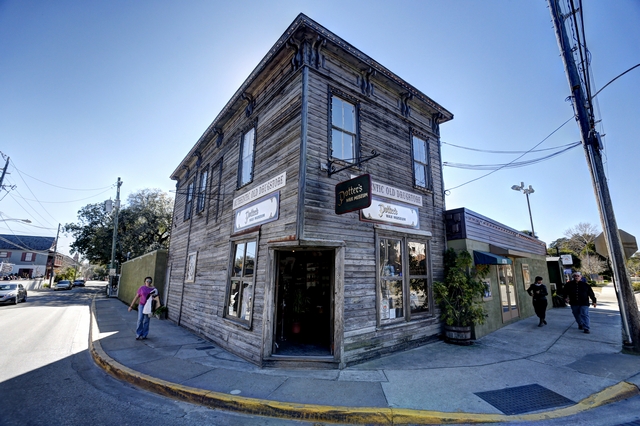
The old drugstore was built in 1886 also out of cedar and cypress. Ed took the photo with his fish eye lens. Notice how the door is built on the corner.
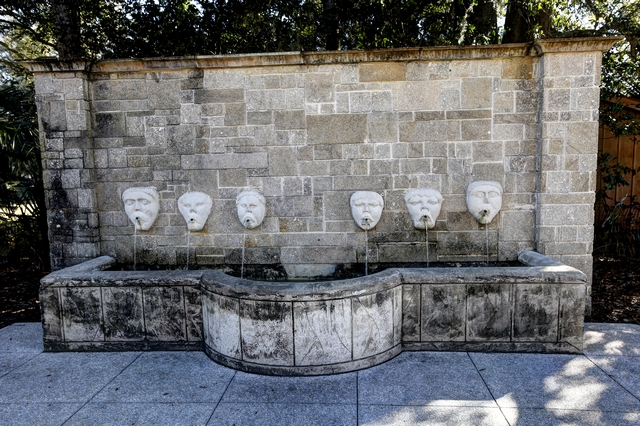
This fountain is a replica of a fountain in Caños de San Francisco in Avilés, the birth place of Pedro Menendez, the founder of St. Augustine.

One of the trolleys we have been riding around town in.
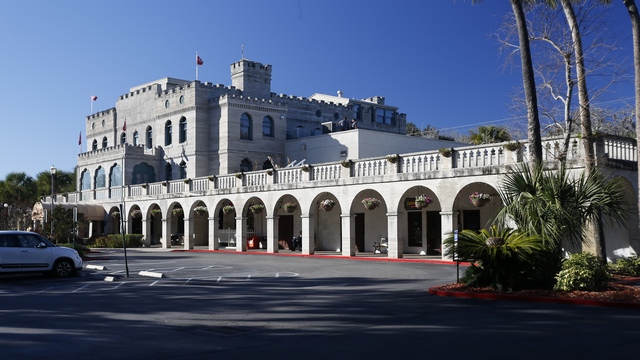
Warden Castle was built in 1887 as the winter home of William Warden, a business partner of Henry Flagler and John D. Rockefeller. It was purchased by the family of Robert Ripley and became the first Ripley's Believe it or Not! Museum.
After several wooden forts were proved inadequate the Spanish built a more permanent fort. Construction of Castillo de San Marcos was started in 1672 and completed in 1695. It is built out of coquina, a rock that is naturally formed in the ocean from limestone and fossilized shells. Coquina is very soft when it is quarried and is left for one to three years to dry. Coquina was handy to build forts with because the heavy cannon balls would sink into the coquina instead of fracturing or breaking the structure.
When the Spanish walled the city in the 1700's this gate was the only way in and out of the city.
This is a model of the fort. Starting from the outside, there is the "glacis", a man-made slope giving the soldiers inside the fort a good view of area surrounding the fort; next is the moat which could be flooded with sea water; finally the walls of the fort. The corners protrude preventing blind spots.

The drawbridge.
The courtyard of the fort. The soldiers lived in the city and came to the fort each day, so there are no living quarters.

One of the storage vaults for gun powder and other ammunitions.

The original fort doors and couple of Spanish soldiers.
A few of the many cannons on display. Notice the design on the middle cannon.
Interesting picture Ed.
A view from the castle wall.
This school house was built more than 200 years ago out of red cedar and cypress. The building is encircled by a large chain, placed there in 1937, to help anchor it the ground in case of a hurricane.
The backyard of the school house contained a kitchen building. Think the chimney has seen better days as a chain is preventing it from falling down.
Wildlife ..... this fellow was digging around in the school yard.

The old drugstore was built in 1886 also out of cedar and cypress. Ed took the photo with his fish eye lens. Notice how the door is built on the corner.

This fountain is a replica of a fountain in Caños de San Francisco in Avilés, the birth place of Pedro Menendez, the founder of St. Augustine.
One of the trolleys we have been riding around town in.
Warden Castle was built in 1887 as the winter home of William Warden, a business partner of Henry Flagler and John D. Rockefeller. It was purchased by the family of Robert Ripley and became the first Ripley's Believe it or Not! Museum.
2014/01/19: St. Augustine
Category: General
Posted by: The Agnew Family
One item on all of the "things to do" lists in St. Augustine is the
trolley tour. When you buy a ticket for the trolley tour it is good for
three days, so as the weather for the next three days is suppose to be
reasonably good we decided this would be the time to take the trolley.
When we were buying our tickets, we found out that if we bought a
package (tour and some of the sites) our trolley time and free parking
could be extended for the length of our stay in St. Augustine. This was
great, now we can take our time exploring St. Augustine. Parking is
expensive in St. Augustine and somewhat hard to find, especially for the
truck, so now we don't have to worry about i.
Today, we started by taking the trolley for a complete tour around town. This gave us a good overview of the city and the trolley route. We didn't take any photos while we were on the trolley as we know we will revisit all of the areas we saw today. As it is Sunday today, there were a lot of tourists in town. We decided to go to the pedestrian mall, have lunch and walk around looking at the old buildings.

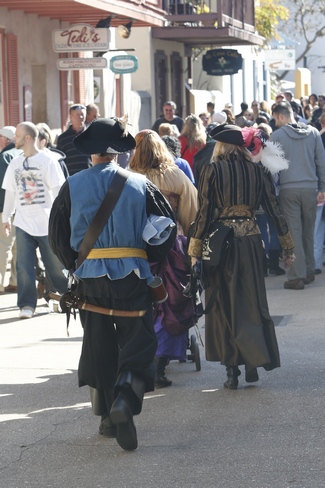
The restaurant we ate lunch at had a bear made from crushed beer cans. Some of the locals walking down the pedestrian mall.
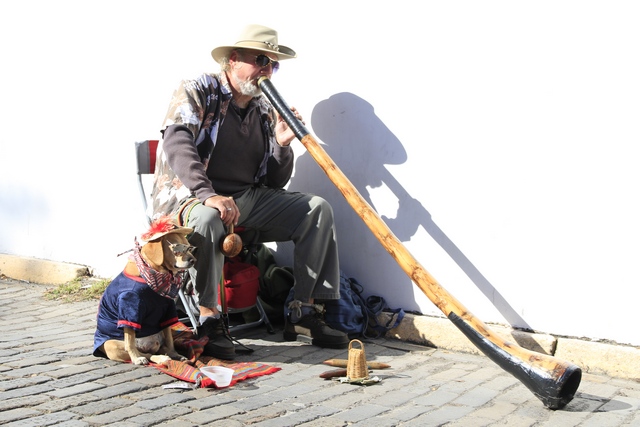
Down one of the alley ways was this fellow and his dog. Not sure what the horn was but it did make and interesting sound. The dog just sat there like a statue, barely moved and didn't make a sound.

In the old part of the city the roads are very narrow. Lots of interesting architecture. Loved all the wrought iron balconies.
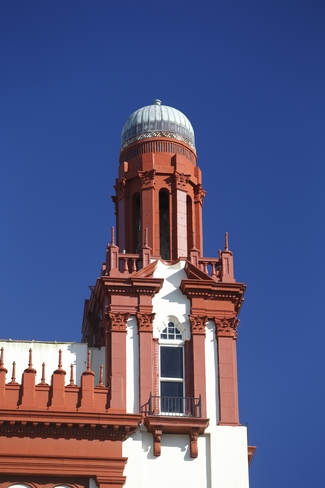
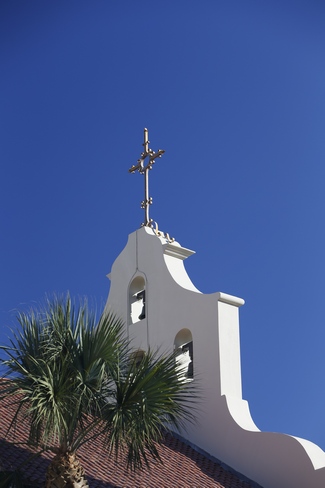
At the end of the pedestrian mall was the Catholic Church. Beautiful building, we'll be back to explore it some more.

The city is filled with beautiful Live Oak trees.

Carol playing trolley driver on the old trolley car.
Today, we started by taking the trolley for a complete tour around town. This gave us a good overview of the city and the trolley route. We didn't take any photos while we were on the trolley as we know we will revisit all of the areas we saw today. As it is Sunday today, there were a lot of tourists in town. We decided to go to the pedestrian mall, have lunch and walk around looking at the old buildings.
The restaurant we ate lunch at had a bear made from crushed beer cans. Some of the locals walking down the pedestrian mall.
Down one of the alley ways was this fellow and his dog. Not sure what the horn was but it did make and interesting sound. The dog just sat there like a statue, barely moved and didn't make a sound.
In the old part of the city the roads are very narrow. Lots of interesting architecture. Loved all the wrought iron balconies.
At the end of the pedestrian mall was the Catholic Church. Beautiful building, we'll be back to explore it some more.
The city is filled with beautiful Live Oak trees.
Carol playing trolley driver on the old trolley car.
2014/01/18: Matanzas National Park One More Time
Category: General
Posted by: The Agnew Family
This morning the sun was shining so decided to take a walk along the beach. The only catch was the temperature.
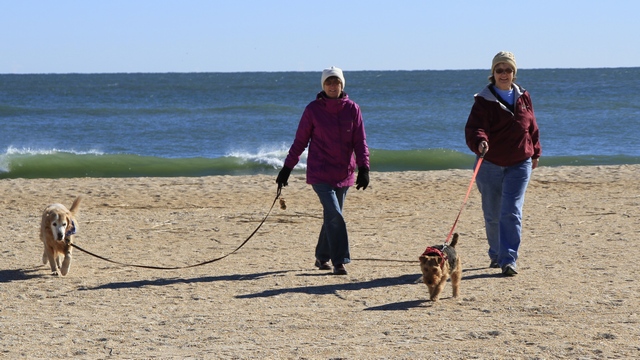
The high today was only 50F so we bundled up --- winter coat, hat and mitts. Shouldn't complain as there was no snow to walk through.
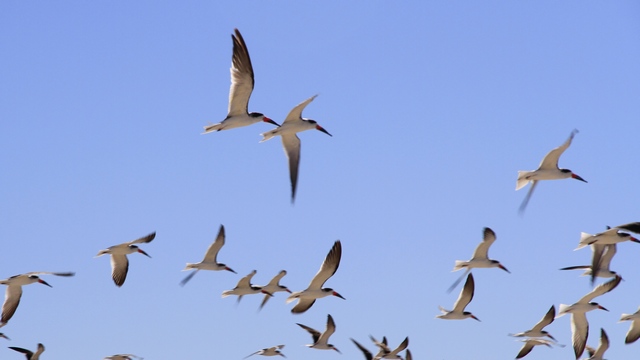
There were a few other people walking on the beach and a number of birds. This folk of skimmers were working their way down the beach.
When we were at Fort Matanzas National Park earlier in the week, we were told about a torch lit night event at the park. As they only do this twice a year we thought it would be a good thing to do.
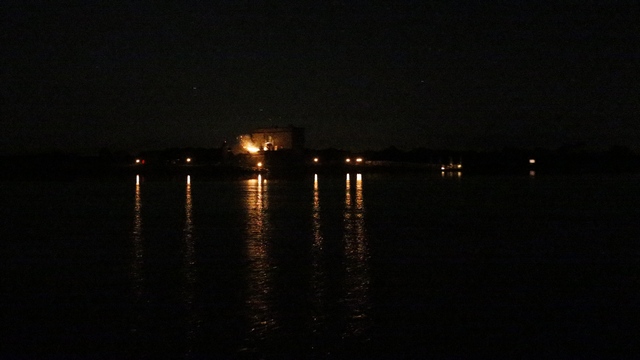
On the boat ride over to the fort, the canon was fired.
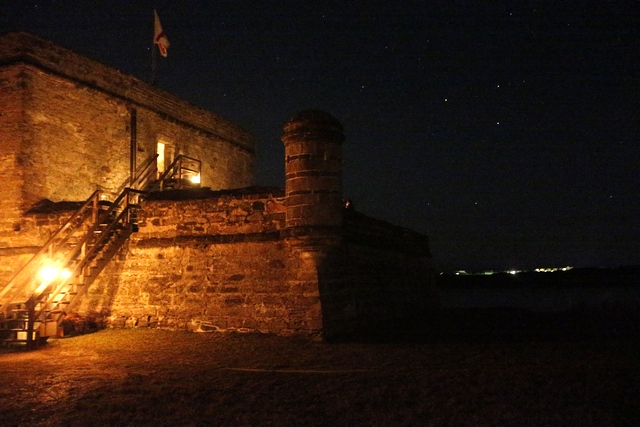
The area outside of the fort was lit by torches but inside the fort the light was provided by candle lanterns --- don't want an open flame near gun powder.
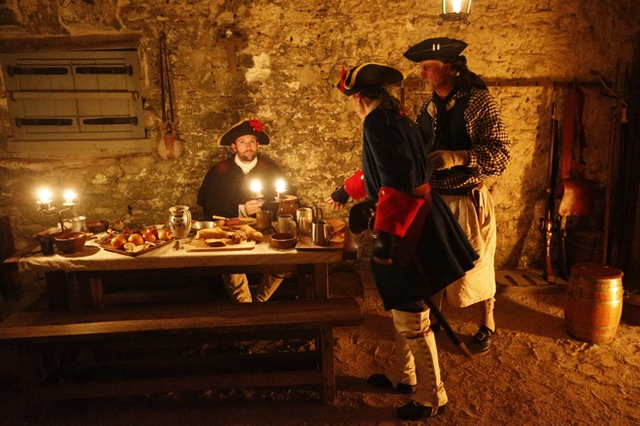
The Spanish soldiers captured a sailor from a ship wreck. In the crews quarters, the sailor was being offered bread and water.
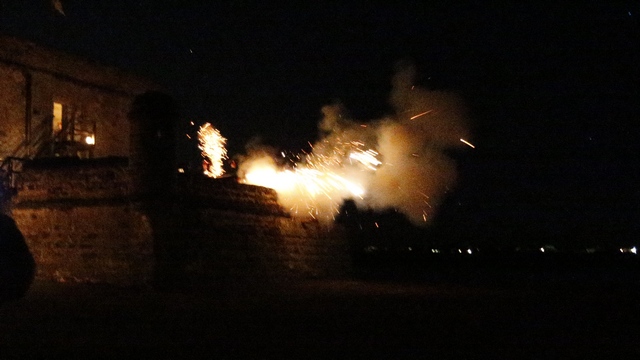
As another boat approached the fort the cannon was fired again. The firing of the canon made quite the show and it was only one third of the normal charge.
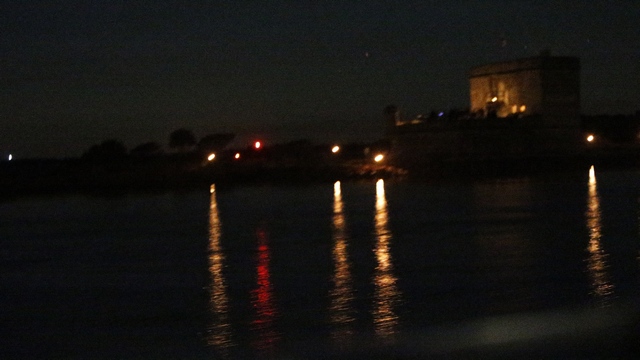
One last look at the fort as we drove back to the dock. We were treated to the view of a huge yellow moon rising in the east and a sky full of starts.
The high today was only 50F so we bundled up --- winter coat, hat and mitts. Shouldn't complain as there was no snow to walk through.
There were a few other people walking on the beach and a number of birds. This folk of skimmers were working their way down the beach.
When we were at Fort Matanzas National Park earlier in the week, we were told about a torch lit night event at the park. As they only do this twice a year we thought it would be a good thing to do.
On the boat ride over to the fort, the canon was fired.
The area outside of the fort was lit by torches but inside the fort the light was provided by candle lanterns --- don't want an open flame near gun powder.
The Spanish soldiers captured a sailor from a ship wreck. In the crews quarters, the sailor was being offered bread and water.
As another boat approached the fort the cannon was fired again. The firing of the canon made quite the show and it was only one third of the normal charge.
One last look at the fort as we drove back to the dock. We were treated to the view of a huge yellow moon rising in the east and a sky full of starts.
2014/01/17: Fountain of Youth
Category: General
Posted by: The Agnew Family
The Fountain of Youth Archaeological Park is pet friendly so our buddies
got to come with us today. First stop was the "fountain of youth" where
each one of us had a drink of the mystical water. Don't think the water
worked though as Zaph and Ed were both still gray at the end of the
day. When Ponce de Leon landed here he was intrigued by the water that
flowed from the ground and by the natives that were taller than the
Spaniards and lived longer than the Spaniards. Turns out the water was
from a natural aquifer and though it no longer pours from the ground,
the underground lake is still accessed for water.
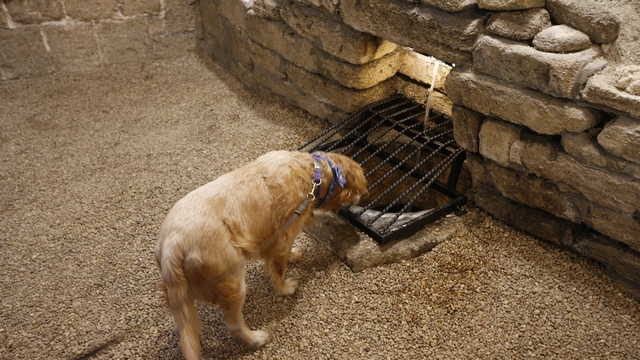
Zaph checking out the "Fountain of Youth". The water no longer flows out of the ground but is pumped.

The Navigator's Planetarium is one of the buildings in the park. Here we learn about navigating using starts.
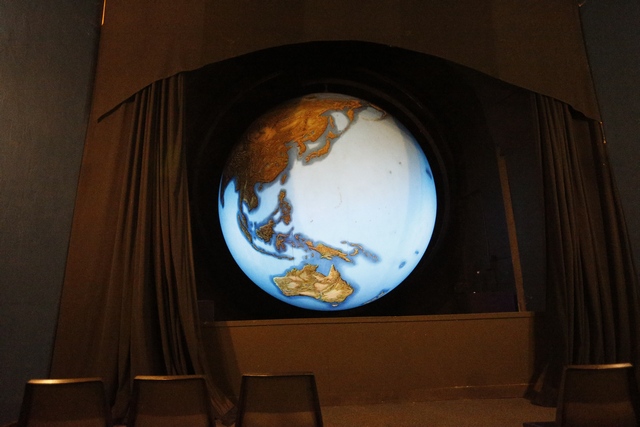
The Discovery Globe is a 30 foot glass globe. During this show Columbus's voyages and Ponce de Leon's voyage are shown on the globe.

Firearms demonstrations were given. Here a fellow is showing us how to fire a crossbow. An interesting fact is this fellow is originally from Hamilton Ontario --- not far from where we use to live.
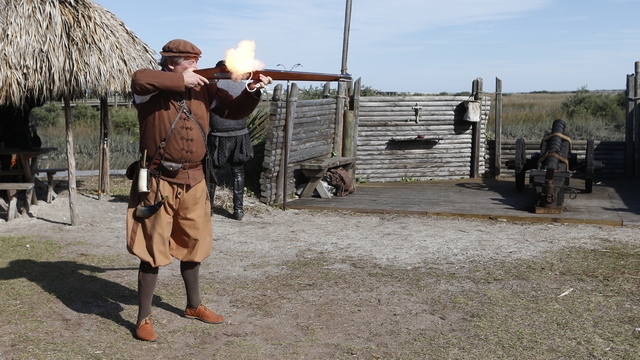
This retired history teacher showed us how to fire a musket. Ed caught the flash of the gun powder as it was lit.
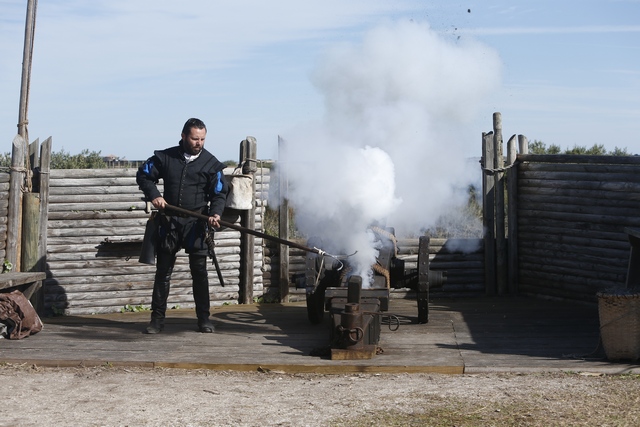
The biggest bang was the firing of the canon. The spots above the smoke are debris fired from the canon. Zaph wasn't impressed with the bang from the musket but he wanted to leave town when the canon went off.

The park is an archaeological site. Building sites from a Timucuan Village along with a burial site have been found. A replica of the village has been built. There were a number of school groups in the park and we were told that as part of the 4th grade curriculum all Florida 4th graders must visit St. Augustine.
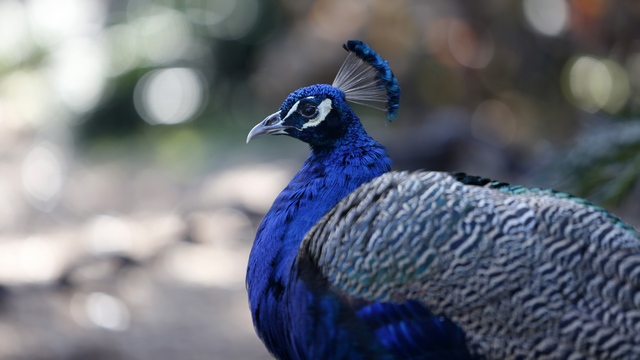
The park is home to a number of peacocks.
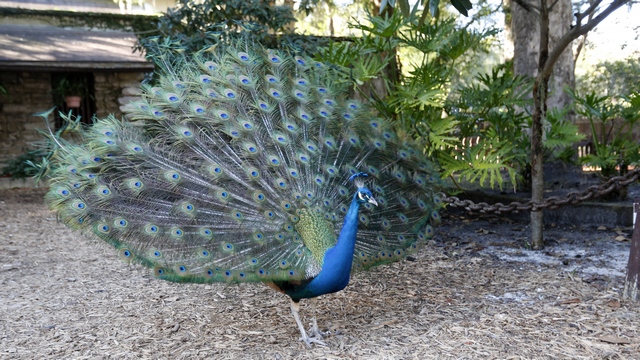

Driving back to the condo we found this Wood Stork having a conversation with an Egret.
Zaph checking out the "Fountain of Youth". The water no longer flows out of the ground but is pumped.
The Navigator's Planetarium is one of the buildings in the park. Here we learn about navigating using starts.
The Discovery Globe is a 30 foot glass globe. During this show Columbus's voyages and Ponce de Leon's voyage are shown on the globe.
Firearms demonstrations were given. Here a fellow is showing us how to fire a crossbow. An interesting fact is this fellow is originally from Hamilton Ontario --- not far from where we use to live.
This retired history teacher showed us how to fire a musket. Ed caught the flash of the gun powder as it was lit.
The biggest bang was the firing of the canon. The spots above the smoke are debris fired from the canon. Zaph wasn't impressed with the bang from the musket but he wanted to leave town when the canon went off.

The park is an archaeological site. Building sites from a Timucuan Village along with a burial site have been found. A replica of the village has been built. There were a number of school groups in the park and we were told that as part of the 4th grade curriculum all Florida 4th graders must visit St. Augustine.
The park is home to a number of peacocks.
Driving back to the condo we found this Wood Stork having a conversation with an Egret.
2014/01/16: Back to the Fort
Category: General
Posted by: The Agnew Family
Hurrah!!!! Everyone was feeling OK today. Unfortunately, the high is
only 53 F today but at least it's sunny. Today, we left the dogs at the
condo and took John with us to go see Fort Matanzas National Monument.
The Fort is actually a watch tower on the Matanzas River guarding the river access to St. Augustine. The soldiers stationed in St. Augustine rotated between St. Augustine, Fort Matanzas and other outposts in the area. Seven soldiers manned the fort.
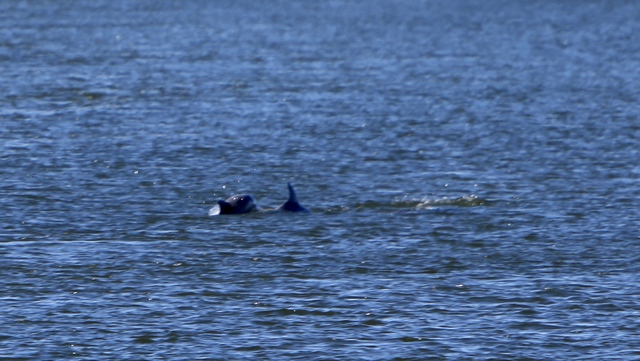
While waiting for the boat, John and Ed saw dolphins swimming in the river.

The Fort is a short boat ride across from the visitor center and parking lot.
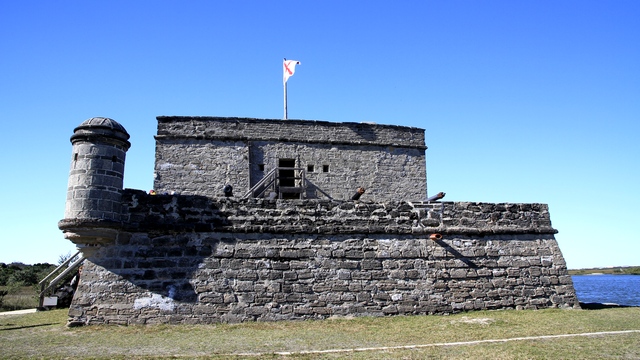
The fort was originally stuccoed in white with some red. When the National Park Services restored the fort, the public did not want the fort stuccoed as they felt it would take away from the "aged" look.
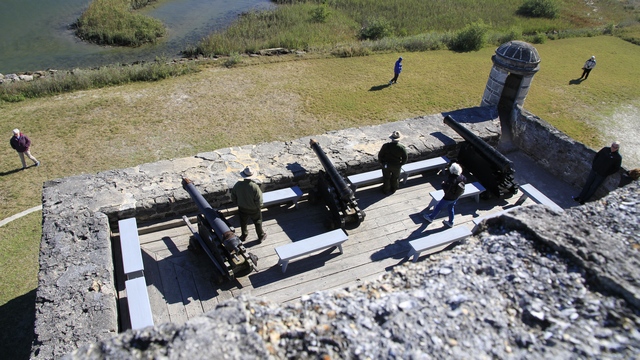
Looking down on the canons and rangers from the main look out.


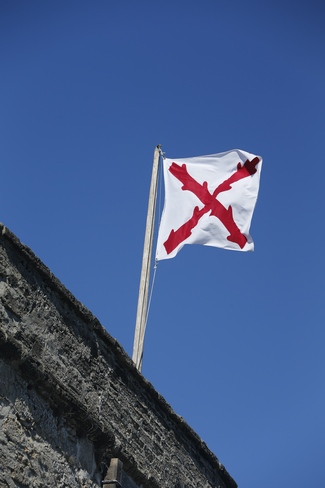
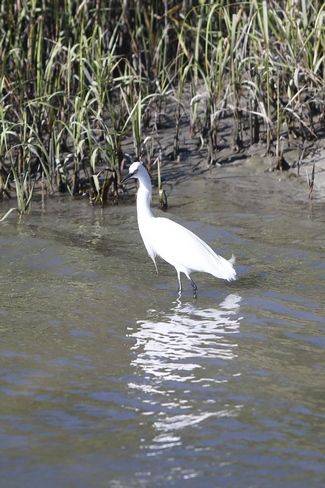
The flag is sometimes called the Burgundian Cross and was used as the Spanish Colonial Flag. The bird is an egret.
The Fort is actually a watch tower on the Matanzas River guarding the river access to St. Augustine. The soldiers stationed in St. Augustine rotated between St. Augustine, Fort Matanzas and other outposts in the area. Seven soldiers manned the fort.
While waiting for the boat, John and Ed saw dolphins swimming in the river.
The Fort is a short boat ride across from the visitor center and parking lot.
The fort was originally stuccoed in white with some red. When the National Park Services restored the fort, the public did not want the fort stuccoed as they felt it would take away from the "aged" look.
Looking down on the canons and rangers from the main look out.

The flag is sometimes called the Burgundian Cross and was used as the Spanish Colonial Flag. The bird is an egret.
2014/01/15: Short Excursion
Category: General
Posted by: The Agnew Family
As John arrived at the condo with some stomach issues and I arrived with
my cold we took it easy the first few days. John was still not feeling
well today, so Carol, Ed, Zaph, Cait and I decided to go for a drive and
give John a chance to rest in a quiet condo. We drove south down the
coast from St. Augustine Beach and stopped at Fort Matanzas.

Cait and Zaph were eager to lead the way down the boardwalk.

The path took us through the forest and out to the beach. We saw several types of licken including red, white and green ones. There were also a number of air borne plants growing on the trees.

At the beach the tide was out so we were able to see the Oyster beds.
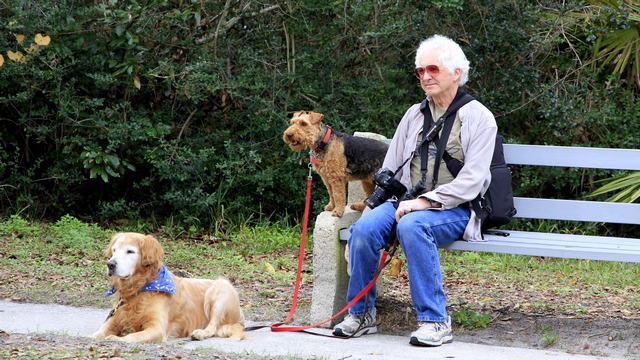
Full alert.

The Live Oaks were interesting to look at as always.
We decided to skip viewing the actual fort until John is able to come. A bit further down the beach we stopped at a boardwalk just past Marineland of Florida. Here we saw a sign telling us that Marineland was originally Marine Studios. It was popular with the tourists but was also used to film movies like the Creature from the Black Lagoon and shows like Seahunt. Today Marineland offers hands on dolphin experiences like swimming with the dolphins or learn to be a dolphin trainer.
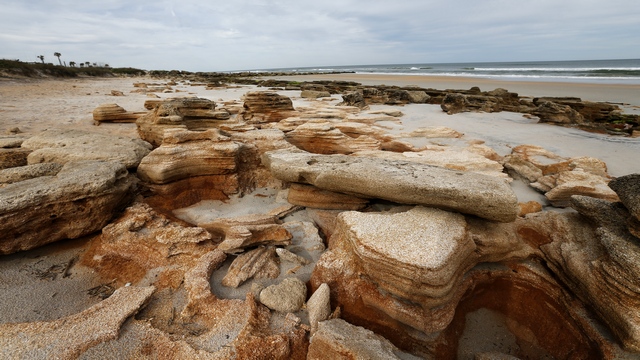
On the beach we saw some some rocks called Coquina, a type of limestone made from compressing tiny coquina clams for thousands of years.
We headed home shortly after this as Ed became ill. Hopefully, we'll all be well soon.
Cait and Zaph were eager to lead the way down the boardwalk.
The path took us through the forest and out to the beach. We saw several types of licken including red, white and green ones. There were also a number of air borne plants growing on the trees.
At the beach the tide was out so we were able to see the Oyster beds.
Full alert.
The Live Oaks were interesting to look at as always.
We decided to skip viewing the actual fort until John is able to come. A bit further down the beach we stopped at a boardwalk just past Marineland of Florida. Here we saw a sign telling us that Marineland was originally Marine Studios. It was popular with the tourists but was also used to film movies like the Creature from the Black Lagoon and shows like Seahunt. Today Marineland offers hands on dolphin experiences like swimming with the dolphins or learn to be a dolphin trainer.
On the beach we saw some some rocks called Coquina, a type of limestone made from compressing tiny coquina clams for thousands of years.
We headed home shortly after this as Ed became ill. Hopefully, we'll all be well soon.
2014/01/13: Florida --- we've arrived
Category: General
Posted by: The Agnew Family
The blizzard ended, and by Wednesday afternoon most of the county roads
were open. Thursday, Ed did some errands and we started packing.
Unfortunately, I was still ill and moved very slowly, so everything took
a long time. Friday we loaded the truck, closed the house for a month
and headed to Burlington where we spent the night at my mothers.
Saturday morning we were up early and started the long drive to Florida.
The border crossing was quick and the rain didn't last too long, so the
days drive was uneventful. About eight o'clock we arrived at Motel 6 in
Statesville North Carolina. Sunday morning we were up early again and
on the road driving south. We arrived at the condo in St. Augustine
about 4 pm., an hour after John, Carol and Caity. Unfortunately, I'm
still ill but I'm getting better.
2014/01/07: Blizzard --- not the type you can eat
Category: General
Posted by: The Agnew Family
It's been a pretty quiet week. Ed's still sick but starting to feel
better, I got sick and think I'm starting to feel better. We've had
bitterly cold weather and now a blizzard has hit. On the news they are
saying that it is the worst winter storm this area has seen in decades. I
found this posted on the Internet.

In fact not only our county closed all the roads but so did the neighboring counties of Perth, Huron and Grey. Ed had the police scanner on yesterday and today and heard lots of reports of stranded motorists, abandoned vehicles, as well as trucks, police cruisers and snow plows that were stuck. A good day to stay inside.

The front of the house from the road. I think the banks are higher than I am tall.

The snow is stuck in all the screens preventing you from seeing out many of the windows. The drifting is crazy in the backyard.

The new shed is faring the best. The old shed has snow half way up the door. The white lump in front of the tree is the picnic table.
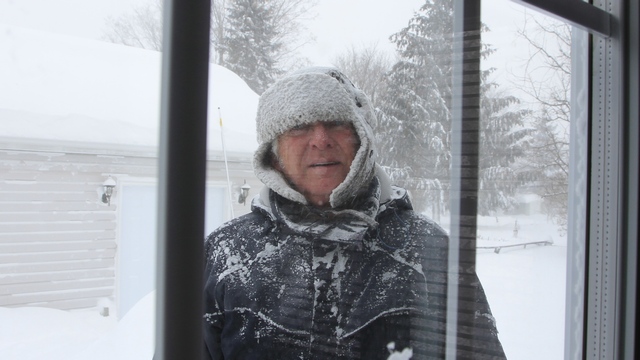

Ed dug some paths for Zaph. Poor Zaph has had enough of winter.
In fact not only our county closed all the roads but so did the neighboring counties of Perth, Huron and Grey. Ed had the police scanner on yesterday and today and heard lots of reports of stranded motorists, abandoned vehicles, as well as trucks, police cruisers and snow plows that were stuck. A good day to stay inside.

The front of the house from the road. I think the banks are higher than I am tall.

The snow is stuck in all the screens preventing you from seeing out many of the windows. The drifting is crazy in the backyard.

The new shed is faring the best. The old shed has snow half way up the door. The white lump in front of the tree is the picnic table.
Ed dug some paths for Zaph. Poor Zaph has had enough of winter.
Category: General
Posted by: The Agnew Family
For whatever reason we didn't plan on doing anything exciting for New
Years Eve, which in retrospect was a good idea as Ed was starting to
feel under the weather. Our neighbors, Rob and Ellen, invited us over
for a drink and to watch their backyard neighbors fireworks. By time we
got home at 12:05 Ed was shivering and feeling awful. Think he caught
the flu. He spent most of New Years day in bed sleeping and I kept
popping vitamin C hoping to keep the bug at bay.